
The Navy Department Library
U-107 Engineering Section War Diary
Document Captured on U-505
-276-
War Diary
“U-107”
Section Machine
Operations from 24 January to1 March 1941
A.) 1.) |
Cool water pump on the port side leaking badly Blowing in no. 3 and 5 cylinder heads. Minimal rotation in the port side exhaust gas turbine. Starboard internal exhaust gas flapper valve indicated closed. Unequal vibration in the anchoring of the port E-motor. Air supply fan switch locked in the last position. Condenser obstructed. Rudder system obstructed. Port tachometer failure. Fixed eye level periscope leaking badly. Failure in the air system. Main periscope jammed in place. Control switch search periscope broken. On board blowing valves in all ballast tanks leaking. Obstruction in the E-motor compressor. Control switch in the trim control had separated from the spindle. |
|
Additionally A 1.: On 1 February the cool water pump on the port side began to leak badly. Installation of the stuffing box, which had been set in place above both packing rings at the Navy Yard Wilhelmshaven. Exchanged packing (cotton packing) was entirely tattered. The damage was further repaired at the Yard with adjustment to the gland stuffing box. The packing was placed opposite that of the original placement by M.A.N. [Maschinenfabrik Augsburg-Nurnberg AG; Machine Manufacturer Augsburg-Nurenberg Inc.] which installed a Fox-Wedge packing. The repair took 4 hours.
Additionally A 2.: On 4 February cylinder no. 3 on the port side began to blow. Pulling on the cylinder heads brought success for only a short time. The badly contaminated copper ring was replaced. Time 12 hours. Towards the end of the operation cylinders 3 and 5 port side continued with light blowing. No measures taken.
Additionally A 3.: Since the beginning of the operation the port exhaust gas turbine rotated minimally. Maximum count n = 430 rpm. The rotations of the port turbine 9with n = 8000) around over 1000 revolutions lower than the starboard turbine 9n = 9200). Externally there are no recognizable irregularities. No measures taken.
Additionally A 4.: On 21 February the interior of the external exhaust gas flapper valve starboard side, previously found to be loose, could only be opened after having been fastened to a counterweight with winding tackle. It was assumed that the bearing shaft was secure and solid during the cruise. The interior of the external exhaust gas flapper valve, due to outside damage, could not be closed.
Additionally A 5.: 25 January. Port side E- machinery anchor pulled severely due to unbalanced vibration. Cause: Clamping bolt of the forward rocker brushes had loosened and the brushes had displaced. Repair time 10 min.
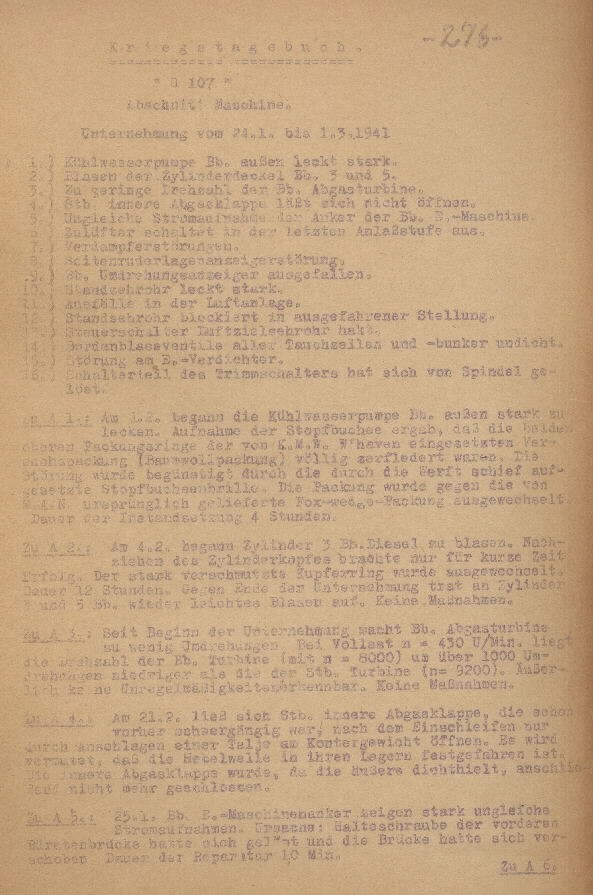
-277-
Additionally A 6.: 7 February. The air supply fan with respect to the series switches for both the fans from the last start step. The cause of the dysfunction was initially assessed in the user switch, by this investigation there has still been no cause for the failure found. It was hereafter determined that the associated circuit diagram does not correspond to the actual switch. Eventually the very harmless failure was found to be the result of the pattern of relaxed security, and because of this the existence of the circuit diagram was not well known and not recorded. Damage investigation 24 hours. This is an example of how, with incorrect or incomplete circuit diagrams, simple work can be delayed or hindered.
Additionally A 7.: 8-10 February. More condenser obstruction difficulty:
1.) Performance went backward, ample steam escaped from the gas condenser. Cause: Leaking from the stuffing box of the vapor concentrate pump and from the installation of the inspection gauge glass.
2.) Severe salt contamination of the heat filament rheostat. The cause was assessed: before the last yard visit the condenser for the brine pump stopped running for an unusually long period, whereby the brine drained off in half an hour. Due to this, the brine build up was not relieved and therefore salt build up occurred.
3.) Replacement strainer in seawater entry clogged, intake interrupted. Cleansed.
4.) Buoyancy regulator leak, condenser overloaded. Buoyancy replacement built in.
Additionally A 8.: On 6 February the steering rudder position indicator measured between 20° and 5° port. A special scale division cannot be set to compensate for this. Cause: Further oxidation in the contacts of the transmitter. Replacement transmitter built in. Time 1/2 hours.
Additionally A 9.: 20 February. Port shaft tachometer indicator failure. The drive chain had initially dropped 12° and had run for a prolonged time alongside the gear rim grinding fiber shavings from the existing gear. No remedy, no replacement at hand.
Additionally A 10.: Within the first dive a severe leak in the fixed eye level periscope occurred. (25.1.) The stuffing box was twisted into a canted angle at the Yard, such that under force it would leak from beneath. After painstakingly and lightly pulling on it, the periscope maintained good pressure [leak proof]. Work time 6 hours.
Additionally A 11.: 4 February. Air valve after capstan on torpedo high pressure air manifold leaking badly. Repairs may only be performed under water after placing in operation the entire high pressure air system, which leaks between the valves after the torpedo high pressure air manifold and before the high pressure feed connection. Both valves were overhauled at the yard and as of the beginning of the operation may not operate in rough seas. Needle indicators show dipping toward the stern section. Work time 2 hours.
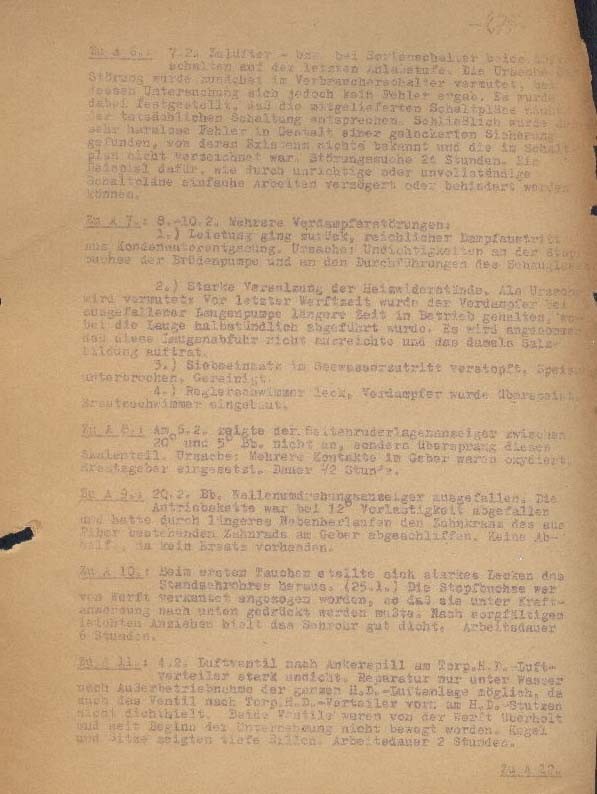
-3-
-278-
Additionally A 12.: 6 February. While heading into an underwater attack, the fixed eye level periscope was locked into the cruise at surface position by an oil leak of 65 ATU [Pressure above Atmospheric]. Cause unknown. With the increasing oil leak the periscope continued to maneuver. Investigation at the yard is essential.
Additionally A 13.: 6 February. Steering switch for the observation periscope cut. The fatigued return stage spring was replaced, the switch was cleaned. Time 2 hours.
Additionally A 14.: All of the onboard valves were blown at the yard during repairs, so as to maintain them leak free from the beginning of the job, so that the blowing connections are always under pressure during each individual dive.
Additionally A 15.: 20 February. The pressure at stage 3 of the Electric Compressor climbed to 60 ATU [Pressure above Atmospheric]. Further obstructions were removed from the pressure valves at stage 4. After replacement work the compressor operated normally.
Additionally A 16.: On 24 February. Following a surface attack on a steamer, the coup de grace should be given while submerged. During the dive the boat listed inexplicably to the stern. Trimming with air pumps forward was not desirable, with “all hands forward” [order for the crew to rush to the bow of the boat] the listing towards the stern passed. After breaking the surface, it was established that the trim switch was loosened from the trim controls following a break in the spindle security plate. From this point on the switch was set in the lower position (to trim from bow to stern). On course for a night attack, the order should be issued for trim water to be shifted to no 3 bow, for flooding in a stern tube and flooding in a bow tube, altogether over 1000 liters were shifted to trim the bow, a great amount, due to the break down of the trim control. The stern was trimmed. By greater attention to the trim control, the correct external trim setting was made with respect to the trim switch, and with knowledge of the correct trim timing. Removal of the obstruction took 45 minutes.
B.) a.: First diesel- mate 3 weeks inactive due to respiratory infection, otherwise nothing to report.
b.: 1. Port engine running uneasily since the last yard time, especially at the lower rpm’s (n = 160…. 20). Oscillation measurement required.
2. The reduction of the receiving time for the radio receiver installed by the Yard at Wilhelmshaven proved it could stand the test. Steam production no longer occurs. Assuming no leaning in the boat occurs, a radio message will not be sent, but leaning should be avoidable through flooding in the diving cells 2 and 3.
3. The sound damping in the negative buoyancy air tanks is very good.
Available diving depth T = 60 meters.
B.) See installment.
The Chief Engineer
Signed: Engler
Lt.Cdr. (Eng.)
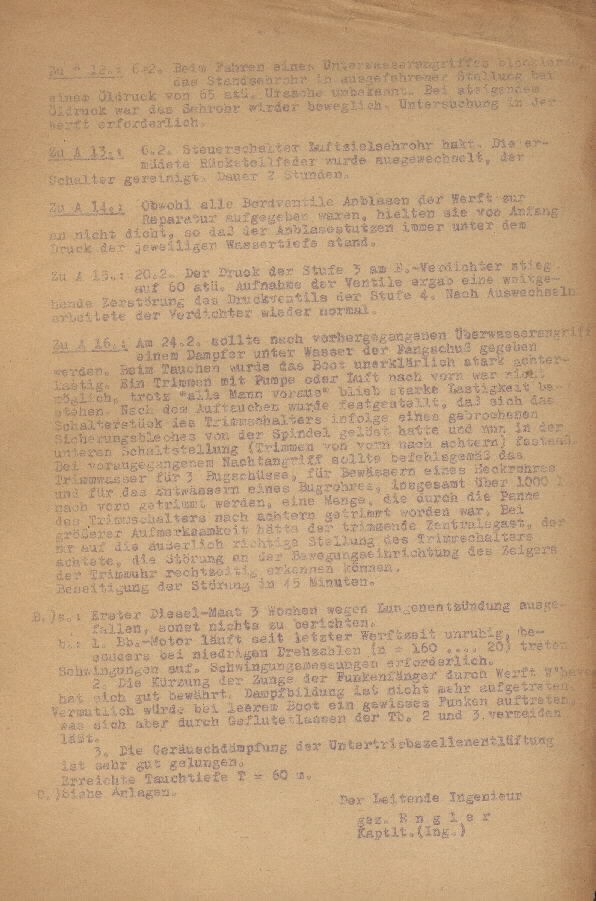
Remarks by the Flotilla:
-279-
Additionally A 1.: Apart from this, it was seen that when the stuffing box was placed in crooked, the packing was not sufficiently wear resistant.
Additionally A 3.: After the yard repairs were performed it was determined that the mounting of the turbine shaft was bent out of shape.
Additionally A 4.: A bronze housing for the lever shaft removed as a result of nearly complete encrustation from combustion and seawater residue. It appears that the bearing setting and the flapper drive and the friction adjustment is always returning with one or another defective bearing settings. Flapper drives and the friction adjustments will always require controlled lubrication. The current lubrication adjustment always returns with one or another defective bearing settings.
Additionally A 9.: Replacement chain and wheel required, this damage occurs frequently.
Additionally A 12.: Bearing support for the gearing dislodged at an acute angle, such that the drive shaft is apparently jammed and splintering through thermal expansion. It must be shut down immediately, and cannot deliver power.
Additionally A 14.: The hull valve blowers are to be checked for closed covers as many boats frequently leak from these. The diving preparation valves position for the blow support must be sealed in order for the valves “to be in good hands”.
Generally, the last in service boats of Type IX are found to have defective air pressure valve implements. For example, standing valve positions and valve spindles with plugs are frequently set non-concentrically to each other, such that after a short time such valves will begin to leak.
The Flotilla Engineer
Signed
Lt.Cdr. (Eng.)
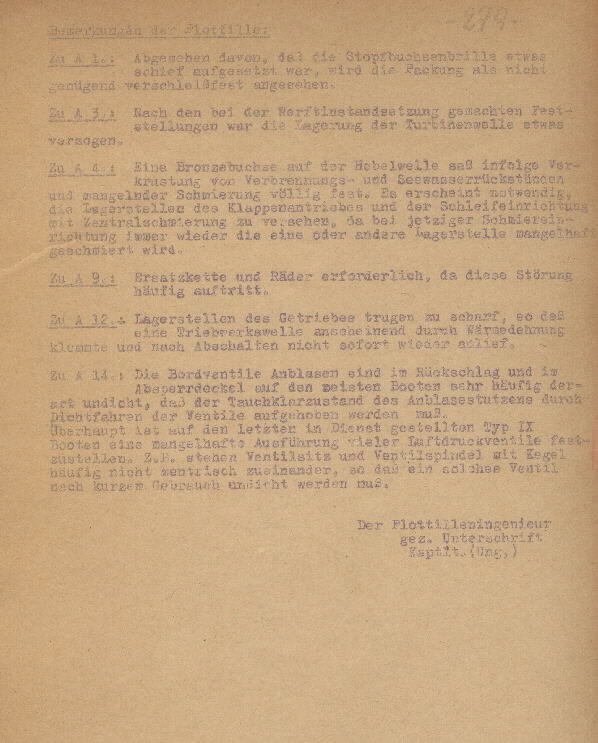
-388-
[formerly] Secret! [subsequently declassified]
War Diary
“U 107”
Section Machine
Operations from 8 September to 11 November 1941.
A.) 1.) |
22 September. Obstruction in the starboard auxiliary cool water pump. 22 September. Water in motor oil. Flood valve of the starboard negative tank leaking. Conning tower leak. Elongation and constriction in a vertical girder for the observation periscope. Obstruction in fresh water generator. Obstruction in the rotary cooling pump. 8 October bearing damage in the gyro compass motor. Drive mechanism for the shaft RPM indicator [tachometer] out of action. Oil leak. Minor obstructions. 8 November. Diving breakdown. |
Additionally A1.: A.K.- Drive [antriebkraft = drive power] (460 Upm.) [UpM = Umdrehung pro Minute = rpm] Misfit in the front plate of the starboard auxiliary cool water pump, which began to flutter. The interface bearing of the crankshaft, and the eccentric bearing for the cool water pump piston overheated, so that (this could not be stopped) it was necessary to apply caloric cooling.
Later it was determined the machine was stopped by an adjusting pin which loosened at the interface, and soon all clamping bolts loosened open. A new adjusting pin was tightened in place, and all screws secured. The crankshaft bearing was undamaged, both eccentric bearings must be reworked.
Cause: the adjusting pin, which was later found in the bilge, was bent, and showed signs of having been reworked to a smaller diameter with a file. The pins and all clamping bolts were insecure. Work time 7 hours.
Additionally A 2.: The manual “After-cooling Starboard Exhaust Gas Driven Compressor.” Draining from a porous section developed in the starboard machine over the driving plate. A light water leak passed through the crankshaft aperture and into the oil circulator. A prior measurement yielded water content of 4%.
The ruptured piping became flanged, the water content was minimized to normal at the Yard.
Additionally A 3.: A few days after the beginning of the operation the starboard negative tank no longer maintained a leak proof seal; the tank flooded after venting. When the cell became flooded, it is likely the rubber seals were washed out, and the metallic valve seals (clearly noticeable) were set up with their reserves. Unfortunately this did not seal the cells; it turned out that by periodically squeezing a
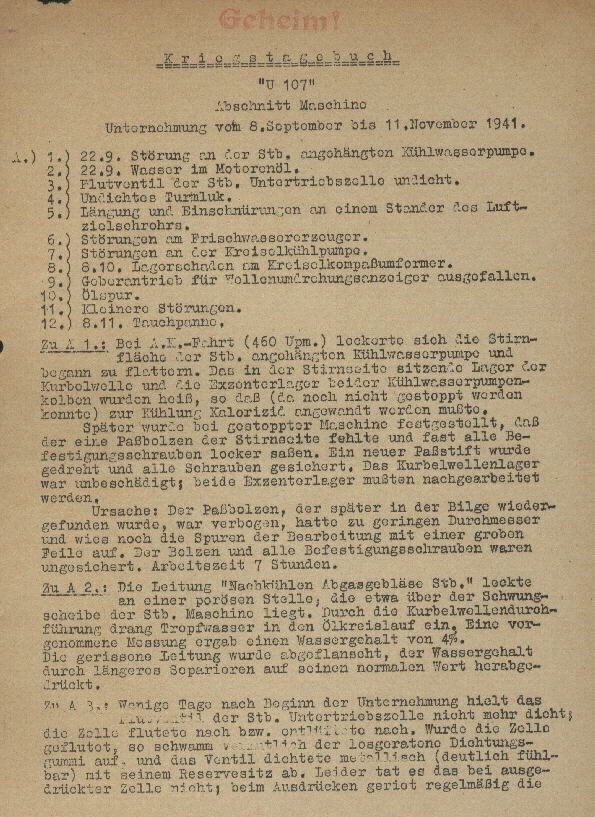
-389-
-2-
rubber gasket (or reinforcing ring) between the valve seat and head, it was possible to lock up the gas valve heads.
For the remainder of the operation the starboard negative tank had to be taken out of operation, a very unpleasant set back and the diving time – especially in rough seas – took longer than earlier. Steps will be taken shortly to remove the obstruction, which, it is suspected, was caused by sloppy installment of the reinforcing ring of the rubber gasket by the Yard.
Additionally A 4.: In addition, not satisfied that the tower hatch is leak proof during pressure diving after performing Yard test dives. The hatch was set in at a cant and rests within its hatch aperture at a slightly canted angle, such that a semicircular gap of one mm. remains open. By the demands of the High Command, they went to the roots of these problems, which were not brought before the Yard; many accept this with the excessive displacement of the locking lug, because with the application of excessive force the hatch can be pulled reasonably flush. That this was only a remedy for a short time was clear from the start. In reality the lug was urgently pulled sharply during diving maneuvers, ensuring that the hatch could be closed with minimal deficiency.
Through wedging a metal plate under the rim of the hatch the cant may be offset a fraction. The pulling lever may be transferred to the center of the hatch.
Since then the tower hatch leak has been adequately remedied.
Additionally A 5.: The retraction of the observation periscope took longer and longer every day, so that soon the scope travel within the brace was no longer adequate. The brace numerical indicator displays a constant decrease. The replacement for the brace was saved, and the scope travel was increased by readjustments in the underlying synthetic scope disc.
Lorient [France] Yard had installed an old brace during the last Yard berthing time.
Additionally A 6.: At the Yard during the essential overhauling, repair of the fresh water generator was not duly ordered by the High Command, there – though an 8 week planned Yard time and a following week of lying up at the Yard according to decree – as it could not become a minor obstruction to running a test run.
In the operational steps up to the first deployment with respect to the minimal operational hours, defects and obstructions appeared, which were attributed to the shoddy work and negligence of the operations performed by the Yard work groups.
a.) Stuffing box and wiring container for the brine pump were packed so defectively that the pump did not work.
b.) between the vapor concentrate pump and the vaporizer there was no packing installed.
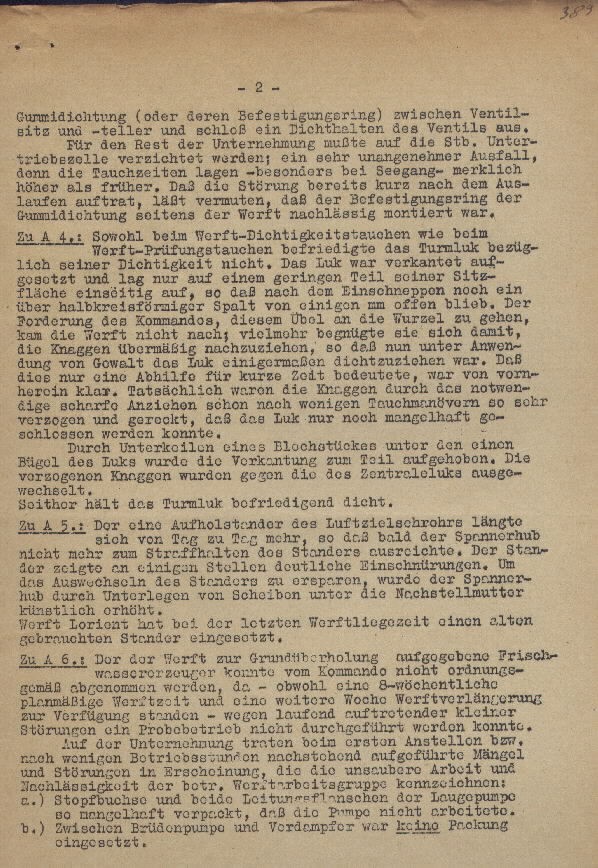
390
-3-
c.) More or less bad leakage in the stuffing box of the condenser agitator works, in the left hand side inspection glass, and in the bolted joint of the condenser entrance and the planetary gear slide.
d.) In the coil connection of the steam barrier guidance to the agitating works pass through, an old rupture in the entire coil, which became enlarged, and was repaired on the way in.
e.) The fresh water selector (Three Selections) leaked and had to be countersunk.
f.) A spherical pivot to the worm-gear shaft to the drive of the mixer and the alkaline electrolyte tank was completely loosened from the shaft, and after a short time, lead to the destruction of the pivot and damage to the shaft.
g.) The condenser was not purified; in the tubes sits a 1 ½ mm, strong, very solid salt deposit.
The main defect constraints now are, the vaporizer must be completely dismantled and removed, for cleaning. New packing and the necessary repairs must follow through. Identify the leakage in place and perform a minor suitable test according to the Operational Manual, which specifies an operational vapor pressure test with 0.3 ATU [pressure above atmospheric ] of practical air pressure.
The worm-gear drive was abandoned after an unsuccessful repair investigation. [the following bold face were all underlined in red ink in the original document] The mixer since then has been repeatedly stirred by hand hourly, the brine removed every half hour.
The performance of the vaporizer has since been very satisfactory with 240 actions per day.
Additionally A 7.: The spring coupling between the motor and pump shaft breaks repeatedly. After use the replacement coupling sections of the motor and pump were rigidly coupled; the lead, on 4 October, to the bridge of the motor shaft, that – which was just underlined – the two shafts lie on top of each other.
The broken shaft was repaired by the attachment of a truncated shaft; after filing down the vertical surfaces of the motor pedestals with about 2 mm taken off from both shafts. An elastic like coupling link made from a helical spring was successfully used to repair the periscope sleeve lead.
For the duration of the repairs (8 hours) the gyro mechanism was cooled with sea water; cooling with low pressure air – which was taken from another boat - proved to be enough.
Additionally A 8.: Irregular beat and strong rattling sound from the gyro converter motor suspected of being caused by bearing damage, which was identified by listening with a hearing rod in the forward bearing of the generator section. After disassembly of the mechanical section and examination of the drive side of the generators, the bearing was removed; surprisingly it was not a roller bearing, (as was depicted in the plans) but a spherical bearing. The bearing placement on the shaft was from something
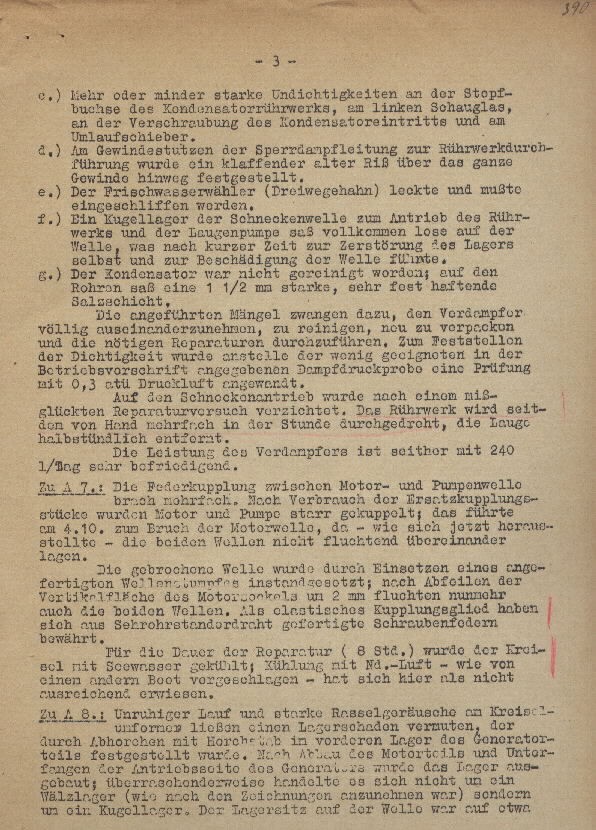
391
-4-
near half of the shaft circumference and worn to 0.6mm.
The shoddy machining of the shaft from the lathe was not up to the sufficiently high tech standards desired; it was due to expediency that the replacement bearing (roller bearing) was removed from the shaft, after falsely blaming a reamed bolt.
As it was suspected, during the last Yard time the roller bearing of the converter motor was interchanged for a spherical bearing. The result was the forestalling of the extension of the axle, and with this, the forcing of damage in a bearing. Work time 9 hours.
Additionally A 9.: The usual time factor for malfunctions is always the same, and one sees no end in deciding on design changes.
Additionally A 10.: Approximately midway through the operation, an oil leak trail appeared, with a change in its intensity, often entirely disappearing, once on the port, once more on the starboard side. The location of the oil leak was not found, suspicion is that while still lying up in the bunker, 3 port, 4 port, port “a” and starboard “a”, after having come to the end of the operation, the oil leak was no longer seen.
Precise examination at the Yard is required.
Additionally A 11.:
a.) 12 September. Metal cool water tube for the gyrocompass ruptured and replaced with a rubber tube.
b.) 18 September. Flexible current lead band on main current contact of the starter protector for the refrigerator broke at the soldered joint; opposite the replaced spare.
c.) 24 September. At the cruising drive power level, an oil leak began in the port motor, with a strong vibration in the motor oil pump, which became hot. Next, it was in addition, followed by the auxiliary motor oil pump.
The obstruction was caused by the return of severe contamination in the vacuum vessel.
d.) One day after the drainage was noticed, the drinking water cell 4 was drained empty through the badly packed man hole cover. The cover was repacked with a new one.
e.) 12 September. The thermostatic expansion valve of the cooling box, for the refrigerant passage, could no longer regulate, and was replaced with a substitute.
f.) 4 October. The valve head assembly of the internal exhaust gas valve for the Junkers compressors had lost their spindle and were scorched and fused rigidly in place. The valve was cleaned and the valve head assembly secured.
g.) 4 fuel pressure lines, 2 fuel needle valves, 1 fuel pump replaced.
h.) Starboard side cool water pumps 5 additional bearings replaced.
i.) Indicator linkage cylinder 1 port motor broken, rebuilt.
j.) Compression valve cap cylinder 9 port motor broken, pressure jammed.
k.) Speed indicator linkage pin bore chamber plugged, cleaned.
l.) The fiber washers of the back seats for the 3 valves on high pressure connecting pipes opposite hard rubber seal replaced.
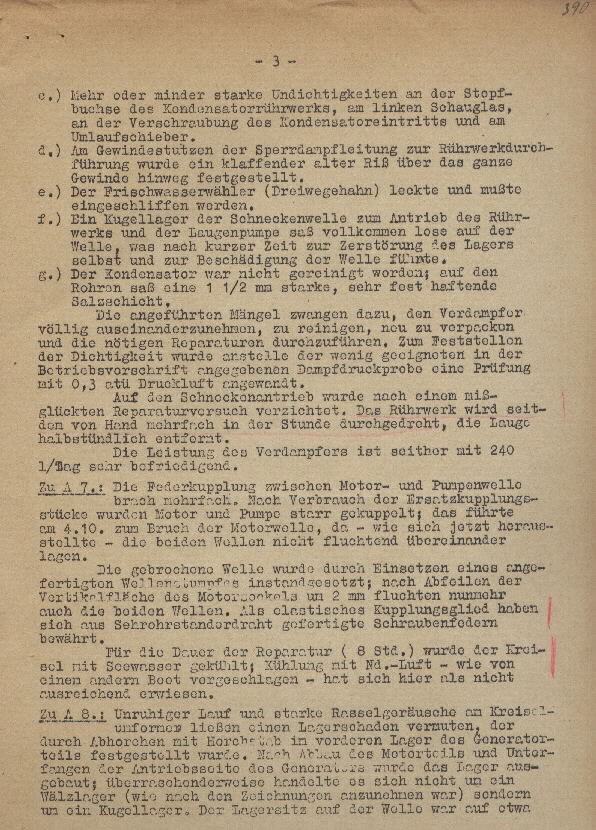
392
-5-
Additionally A 12.: During an alarm dive due to an aircraft the boat remained caught up at 9 meters at the waters surface. Surfaced (aircraft had gone). Initially, there was no explanation, therefore a test dive was performed, with 9000 liters of negative buoyancy available, and after trimming off 1000 liters, towards the stern, the boat can be sustained at 20 meters, though all indications are it will need powerful air blowing. The test in all bunkers in flood conditions with residual air yields no results. It remains only for conjecture, that the water leak has not caused flooding in the stern due to clearing ventilation. Though it is relatively insignificant, the trim water quantity of 1000 liters, by the observations of the First Watch officer, who before the dive, had seen a missing water vapor column over the ventilation of the stern water leak.
Surfaced. On account of the rough seas, a limited investigation of the actual jammed ventilator water leak in the stern was not desirable, this is often the case.
Test dive. This is the outcome. Due to repeated tests of emergency venting, after one week, all tanks switched in fuel ballast tanks 4 starboard and port air. (With the first test dive the emergency venting was opened for a short time, so that only the pipes could drain water). Unlikely as it is, it remains to be presumed that the emergency closing valve had been verified closed. Decision: Fuel ballast tank 4, during the middle of the emergency venting had vented (normal trim condition was returned), for the rest of the operation during cruising it remained flooded.
Surfaced. Through an adjustment made in the drive oil tank belonging to the closing in the vent line stop valve, the astounding cause of the obstruction is attributed to this: both closed slide valves were loose; and the handle of the crank and the crank shaft to both slide valves had a large rag entwined around them, which – as it was obvious, and no other explanation could be given – with the rough seas at the point of attack, had slowly caused the slide valves to be jammed. An unauthorized operation of the slide valves must also be a possible cause, but for days the top deck could not be accessed due to rough sea conditions.
Fuel ballast tank 4 was later switched to fuel tanks, the vent line stop valve secured.
B.) a.: Insignificant loss due to sickness, otherwise nothing to report.
b.: 1.) It is because of the high number of damage reports noted, the security (Damage A 1., 4., 5., 6., 7.,) or probably (damage A 3., 8.) from inexpert work, that we are to return to the Yard.
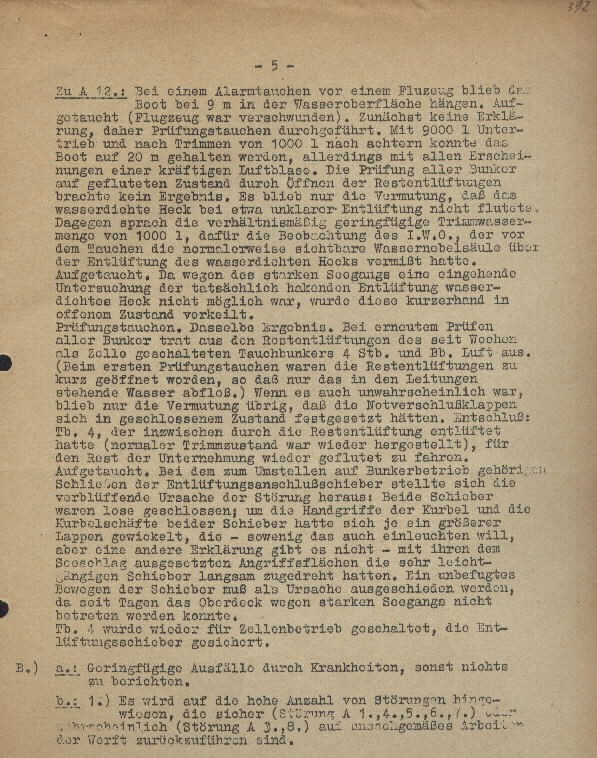
393
-6-
2.) Diesel engines: The following consumption figures were ascertained:
1 |
Engine |
HF [High Forward] |
= 220 rpm |
Consumed: |
70 L/h |
1.7 m³/day
2.2 " 2.4 "
|
Both engines |
HF |
= 250 rpm |
" |
165 " |
4.0 " |
|
Fuel for 1000 Ampere hours (exhaust switch) 35 liters
Fuel for 1000 " ( Pure Supply) 49 liters
Lubricating oil consumption was 2.8 liters motor oil/m³ fuel oil.
3.) Ventilation: “Diesel Main Air Induction”. During the entire operation, its application was described only in the last War Diary. The crew rapidly familiarized themselves that the diesel bulkhead could be opened in 20 minutes after pressure equalization. This restriction on operations in the aft ship was found to cause minimal discomfort, and in any case the advantages were proportional to the disadvantages.
4.) Fuel Supply from Fuel cell 7.: The transfer of the supply from fuel cell 7 to the lead section of the cells is good. The entire cell contents can now normally be shifted and the empty cell removed.
5.) Regarding auxiliary equipment – from the base, there is a higher motor oil usage in a number of South boats – 1 m³ of motor oil is taken in canisters. The canisters are placed in the passage between the motors without taking up great space.
6.) Diesel Compressor: In the last Yard time a new diesel compressor was installed on board, the first of its type, able to hold out obstruction free for over 80 operational hours. The careful treatment of the compressors made possible the prevention of water invasion, with instructions:
a) only to place, when ( at night, as ordered) no alarm is expected and after the exhaust gas valve is shut down, great care is taken to avoid grinding.
b) In rough seas only then, when the port diesel is running,
c) With diesel compressors only up to 190 pressure above atmospheric, continuing with electric compressor pumps.
Attainable diving depth: T = 62 meters.
C.) See installment.
The Chief Engineer
Signed Engler
Lt.Cdr. (Eng.)
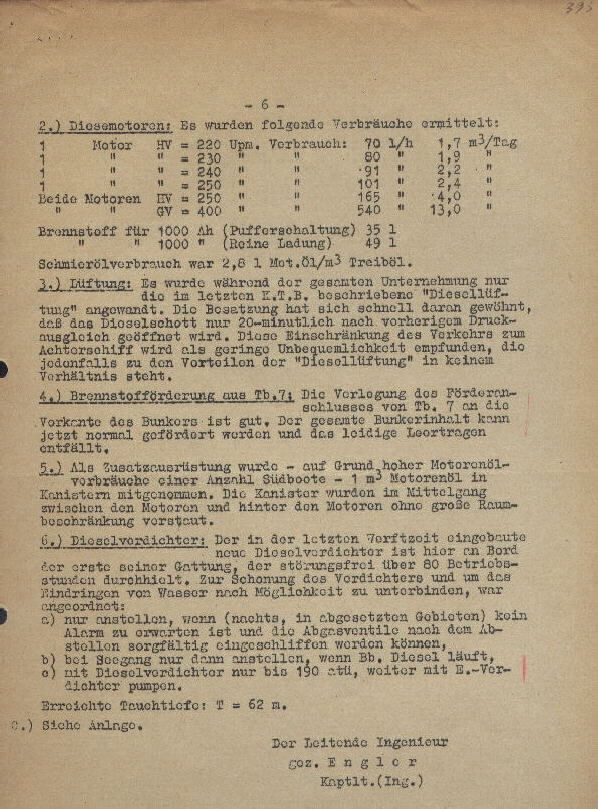
394
-7-
Remarks by the Flotilla:
Additionally A 1.: Navy Yard Lorient commented on the bad design overhaul work.
Additionally A 2.: Corrosion detected.
Additionally A 3.: The integrity of the rubber seals in the valve heads is not so safe, it is enduring hard stress, therefore because of the entry of considerable high pressure in the cells, it is mandatory to ascend to periscope depth. In the boat, frequently having first blown at 40 meters depth, maintained till 13 meters is attained, the rubber seals will experience light leaking.
The boat must, in view of these dangers, blow out at 40 meters, with respect to ascending and venting air.
Additionally A 4.: The difficulty with securing a safely closed hatch is due to an adjustment in a single spring mechanism, fixed to an insufficiently robust hatch mounting.
Always continuing complaints about boats, how the hatches are set off center. In one case a boat at sea announced a gap of 10mm. The bolts in many hatches are extracted unevenly. During the current trial run, the hatch of “U 107” was set in crooked due to the closing of a 3mm wide gap on its port side. This work must be given priority so no more anxiety will come of this.
Additionally A 5.: ./.
Additionally A 6.: The delivery of the fresh water generator is a virtual problem, at least in the boats which have been cleared for operations from the closed yards.
For repairs to go smoothly, a basic acceptance test run at the closing test is mandatory.
In order to maintain continual functioning of the fresh water generator, it is necessary to go through a special convoy operation column.
Additionally A 7.: New Pump!
Additionally A 8.: Cause of the sound from the spherical bearings is not precisely determined. This transformer must come with an exactly compatible spherical bearing, in order to provide the overall best sound suppression, as in a ball bearing, and be tested.
“U 107” has received a new transformer.
Additionally A 9.: The view of the High Command is that this is absolutely necessary.
Additionally A 10.: Leaking in the cells remain without success.
Emergency flapper valves and test circuits were all over hauled. Test dive made without oil.
Additionally A 11.: a) The metal tube is vulnerable to breaks, express requirement for a rubber replacement for operational security.
f) Defective safety is a persistent problem area.
Additionally A 12.: The [gate valve] slider was actually unusually light and smooth operating, which is confirmed by all officers and all bridge personnel, as attested to according to their understanding, and as to their duty. Although simultaneously and similarly the process is very hard on the limitations of what is possible. The slider is generally packed with such precision that the passage of it is very difficult.
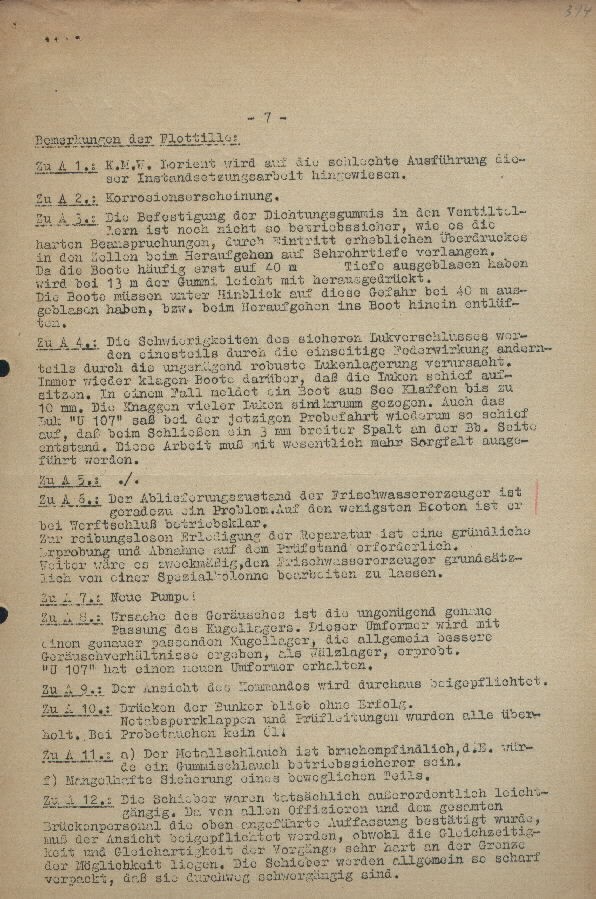
395
-8-
Additionally B.b. 6.: The arrangements of the Chief Engineers are an expression of the esteem they are held in with their ability to perform repairs on such difficult machinery.
Navy Yard Lorient has duplicated.
The Flotilla Engineer
[signature]
Lt.Cdr. (Eng.)
[The back of this page has red inked stamps and handwritten pencil notes]
[stamp]Command
4th U boat Flotilla
B. Nr. 4330
[stamp]Secret!
[written]18/12/41
“U 505”
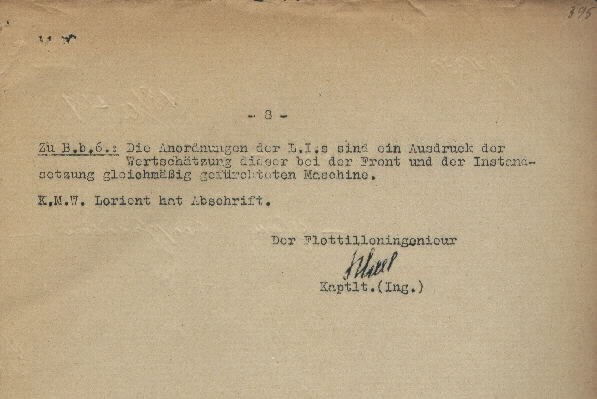
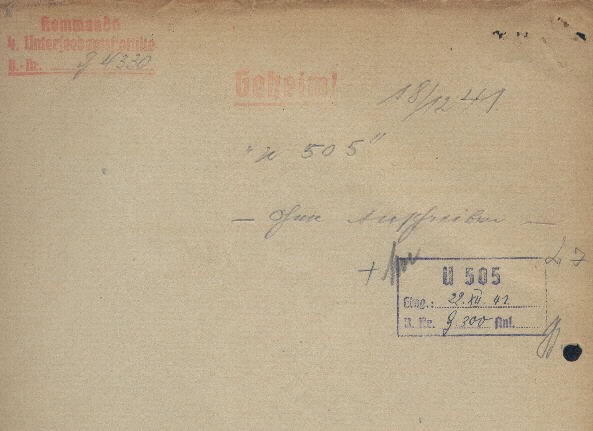
434
Secret!
War Diary
“U 107”
Section Machine
Operations from the 10th December to 26th December 1941.
A.) 1.) E- Compass transformer repeatedly fails.
2.) Fixed eye level periscope, view unclear.
3.) Starboard external exhaust gas flapper very difficult operating.
4.) Minor damage.
Additionally A 1.: During the Yard lying up time from 13th November to 6th December 41 the electric compass transformer was replaced with another taken from the storage depot. Through a test run on 8 December it was not satisfactory. It was replaced with transformer Nr. 711 223 from “U 111.”
Preparations after 24 hours of operational time, dropping the tension from120 Volts = approx. 333 Hz to 50 V = approx. 55 Hz. A brush from the excitation collectors was washed from its footing. The entire 20mm length came to rest in a groove 0.2 mm deep. The collector can be cleaned up and polished onboard. In spite of refurbishing the brush and its proper operating setting must be replaced in the transformer 3 more times, removed and scoured.
Additionally A 2.: Preparations made on board for the fixed eye level periscope on 9 December were made according to advice from High Command concerning the obstructed view. In spite of regular adjustments in the mirror – ocular head – and the cylindrical sight, the obstruction continues to get worse. The highest precision in the six position magnification lever is given at the 1mm end position. The old obstruction, in which the hand operated drive would operate between rough and fine in rough seas, abated after a few days. The existence of a lose turn radius of 1 - 2° in the sky periscope is exacerbated very much by rough seas.
Additionally A 3.: The starboard external exhaust gas flapper valve was, in spite of fundamental repair preparation, again having problems. In spite of continuous operational movement, two important emergency dives were closed by two sailors. Perhaps the closeout will find the location of more external lubricating places and improved lubrication points, which then may be lubricated in rougher seas.
Additionally A 4.: a) On 20 December. Water in the diesel room bilge was noticed. An investigation of the starboard cool water pump revealed that a rupture in the junction turn of the warm water return lines – cool water vacuum lines caused leakage. The engine, for military reasons, cannot be stopped for long, the leaking can not be sealed.
b) Because of a tear down in the tapers to the starboard cool water ventilating lines, the leaking was sealed with a rubber sleeve.
c) After the break in the cool water lines, after cooling in the starboard exhaust gas turbine lead was sealed with a gasket.
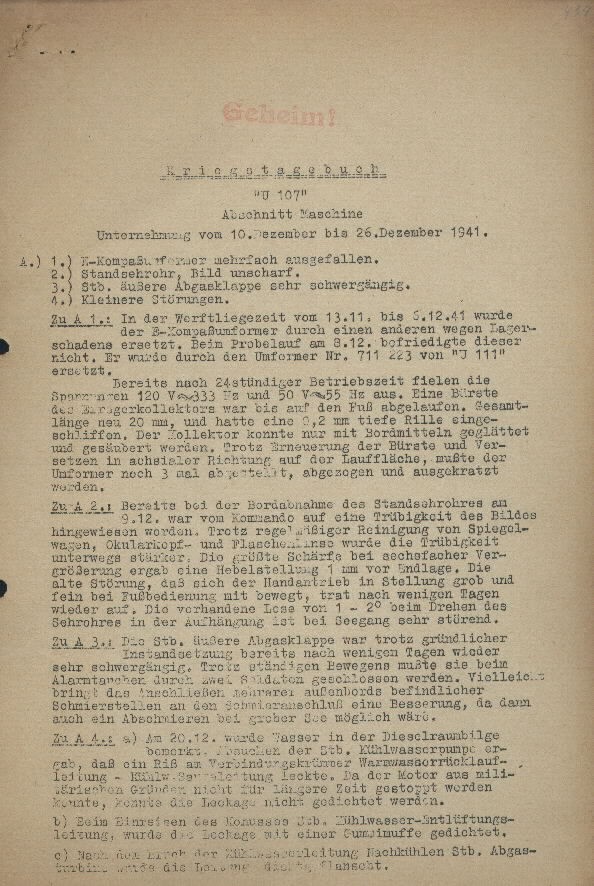
435
-2-
d) On 17 December. The steering repeater in the tower failed. After the exchange in the central, it indicated accurate transmissions, however after a few days it fell out again. Suspected cause, defective contact.
e) On the same day a pull in the repeater was noted. It was repaired, the cycle of reinforcing work was not flawless.
B.) a.: The new recruits, during the Yard recuperation time for service and later on board, performed well in their new responsibilities. Nothing special to announce.
b.: 1. Diesel engines: From the previous journey, fuel consumption was confirmed high. The high rate of lubricating oil consumption of 5% was clear during the operational time, and caused by the oil stripping rings. First, by the difficult and late discovery of leaking in the ventilation line coming from the starboard oil cooler, further oil loss is presumed to be from leaking between the crank case body and the frame chassis of the fastening points to the port engine cylinder 7/8 internal chamfer edge.
2.) Electrical System: A daily cruise measurement indication shows equal acid leaks/electrolyte, indicates an average loss of 25%. By corresponding refinements and the installation in the control room of a precision measuring instrument, the exact values could be made during the underwater attacks.
Diesel compressor, freshwater generator, nothing notable.
Attainable Diving Depth T = 55 meters.
Overall operational time for the diesel engines since commissioning:
Port.: 3,634 Hours 23 Minutes
Starboard.: 3,613 Hours 46 Minutes
Overall operational time for the diesel engines during the operation:
Port.: 302 Hours 39 Minutes
Starboard.: 295 Hours 53 Minutes
C.) See installment
The Chief Engineer
Signed: Boer
1st.Lt. (Eng.)
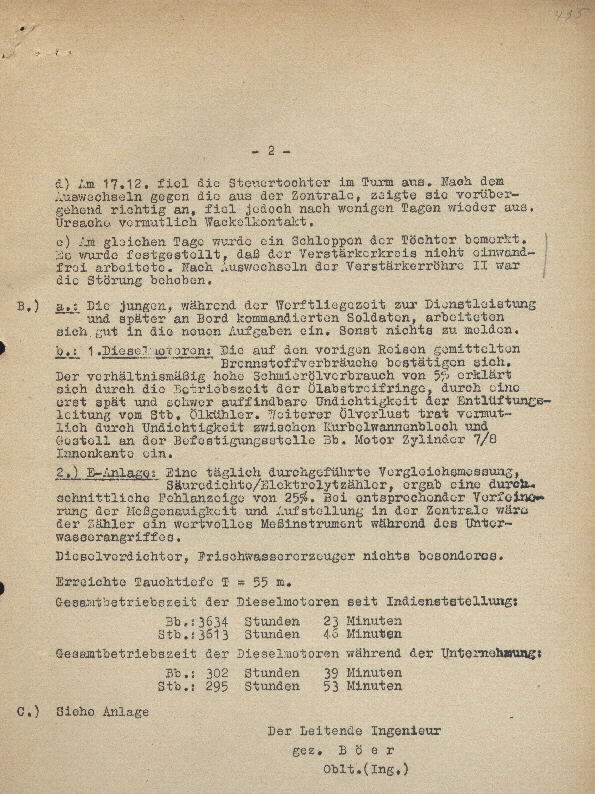
436
-3-
Remarks by the Flotilla:
Additionally A 1.: Unsuitable brush material.
Following the announcement about this from Navy Yard Lorient Nr. 6 1064 IV E from the 7th December 1941.
Additionally A 2.: Cause: Disgruntlement with the lens system for the magnification selector.
Additionally A 3.: Starboard external exhaust gas flapper valve now sustained, though with a loose bearing.
Additionally A 4.: ./.
Additionally B.b.1.: A number of screws from the crank case metal body were bent, especially in the contact points with cylinder 7 and 8 port engine.
Additionally B.b.2.: The electrolyte counter must frequently be readjusted in order to work – with a negligible failure percentage. Movement in the counter in the control room is unnecessary.
Navy Yard Lorient had duplicated.
The Flotilla Engineer
(signature)
Lt.Cdr. (Eng.)
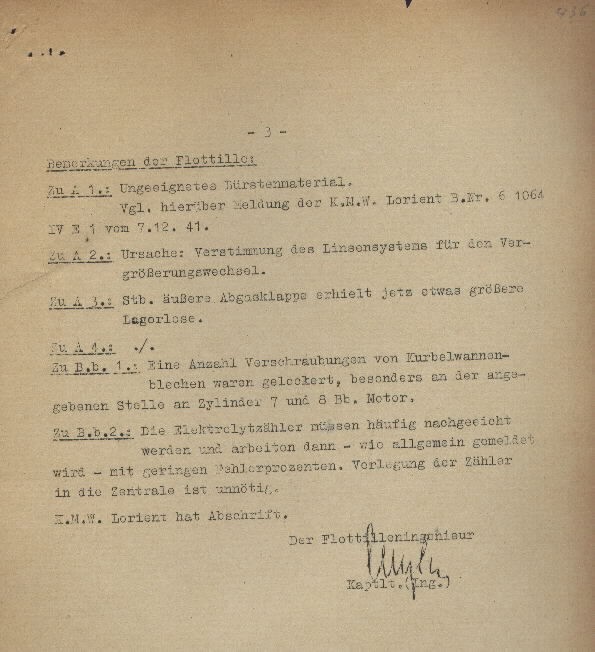
64
U 505
Secret
War Diary
“U 107”
Section Machine
Operations from 7 January to 7 March 1942. (5 Operations.)
A.) 1.) Diesel Obstructions – Cool water pumps, Couplings.
2.) Periscope obstructions – Final position switch.
3.) Damage: Fuel Oil Bunker Port Side a, leaking.
4.) Depth Charge – Losses.
5.) Minor Damage.
Additionally A 1.: Report after 310 operational hours had caused loosening in both crank bearings in the starboard cool water pump with displacement from 1.2 to 2.0 mm. A fitting opening was possible by filing down the mating surfaces where necessary in all of the extracted linings, though it was not necessary for both eccentric non circular surfaces to be measured and cut to 0.3 to 0.5 mm. Though the eccentricity in the port cool water pumps fell equally into noncircular revolutions, both pumps had settled into stable operation. With around 250 rpm cycles with the cooling pumps, cooling was possible with the replacement cool water pumps.
Duration: Port 3, Starboard 5 hours.
Frequent malfunctions.
Both main coupling clutches and pressure bearings generated revolutions under 230 rpm’s. Very strong vibrating sounds.
Both shafts must be measured and re machined.
Additionally A 2.: After the fourth test dive the chain of the lower terminal position switch – sky periscope – exploded. At the same time, on 28 February, following a test dive, the chain drive for the sky periscope ruptured and sprung loose from the notches on the cylinder, causing intolerable damage, as the periscope must be raised. Both chain gears are out of commission, not escaping damage, and the chain leader is down. It was up to now not possible, to put in a request for multiple chains in Lorient.
Because of rough seas the couplings of the drive motors are slipping for and aft. It is imperative that new couplings be installed.
Additionally A 3.: On 23 February in the “U 107” an upper fuel oil cell had a light jam up. The external cell had the upper surface edge area of 2m² bent upward at the hull depth of 2 meters. The 17.8 m³ of fuel were immediately washed out by the sea, and an immediate drain inspection indicated it was not safe.
Additionally A 4.: On 12 February the boat underwent depth charging at 20 meters.
Failures:
Self activating clutch to the forward hydroplane drive motors, safety indicator for forward hydroplane position indicator.
High speed air safety alarm.
Trim pump has from this point in time a grinding sound coming from it, but not the whole system. Indicator to all rpm indicators concealed.
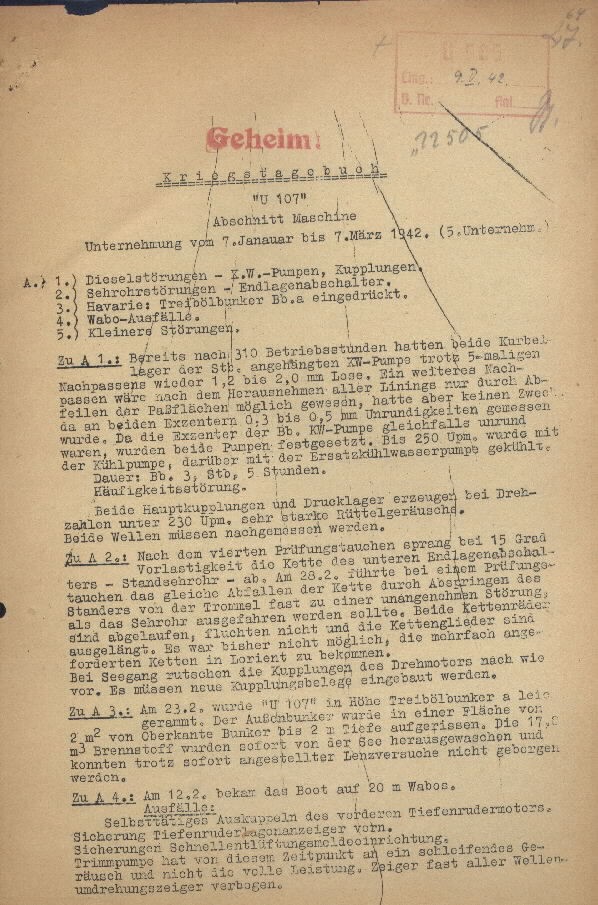
-2-
Additionally A 5.: Minor damage:
1.) On 16 February. During action in an alarm dive in front of a destroyer, an improper valve setting caused 1m³ of water to enter the aft trim cell. In short time, a buoyancy blowing pressure of 5 ATU [pressure above atmospheric] was immediately vented through vent blowing.
Operations failure (2. Central Machine Telegraph).
2.) On 17 February. A bolt was lost from the starboard external gear of the operating shaft, so that the shaft rotates loosely. A new bolt was placed. As of the 2 March diesel damage repeated, cannot perform repairs due to rough seas.
3.) On 3 February a large leak occurred in the cool water pressure valve casing through a rupture 4mm² wide, caused by corrosion. Sealed with clamps.
4.) The operation indicates that the newly installed vaporizer does an adequate job of transferring lye and condensation. The flow level must continue in case of failures, or remain greater than 0.
5.) After the failure of the cool water pump’s diesel compressor, (fed by the shaft in the forward bearing bushing, striking against the clutch coupling) it has been found, nevertheless, that the cooling pump continues to operate. Repair time 2 hours.
Frequent breakdown.
6.) Rundown in the gyro motor. Sparks coming from the replaced brushes.
Duration: 20 minutes.
A.) a.: The boat has, after every operation, given up to ½ of its technical soldiers [sailors] for Senior Petty Officers respectively for Under Sea Cadets, whom average 8 review recommendations. The replacements, especially those of the petty officers, are under the average and barely fill the required posts. (See obstructions).
Minor difficulties because of dental problems and forunkulose [?] which was not cured in port.
b.: 1.) The high lubricating oil consumption of 5.6%, in spite of lower rpm’s, the condition of the piston bottoms and the color of the exhaust gas requires urgent replacement of the pistons and oil wiper rings.
2.) The refueling would take place during lighter seas.
Both boats maneuver in parallel to perpendicular at sea with E – motors,
Perpendicular 20 to 30 m. Both fore stems are connected with a single hemp rope. The fire fighting hose and a second line are floated off the western side. Auxiliary lubricating oil pump leaked 12.5 m³ in 35 min. from the empty regulating tank. (0.35 m³ /min.) It was from the forward section in the lead line that a viewing port was located, but it was not, in this case, where the 3.5 m³ of water had flowed from.
3.) Because of the weather conditions in the north Atlantic, the navigation system fell out of operation due to atmospheric difficulty. The dynamic and static pressure in the boat has, with severe sea conditions, risen to high levels in the control room. (by U D 3 – 5).
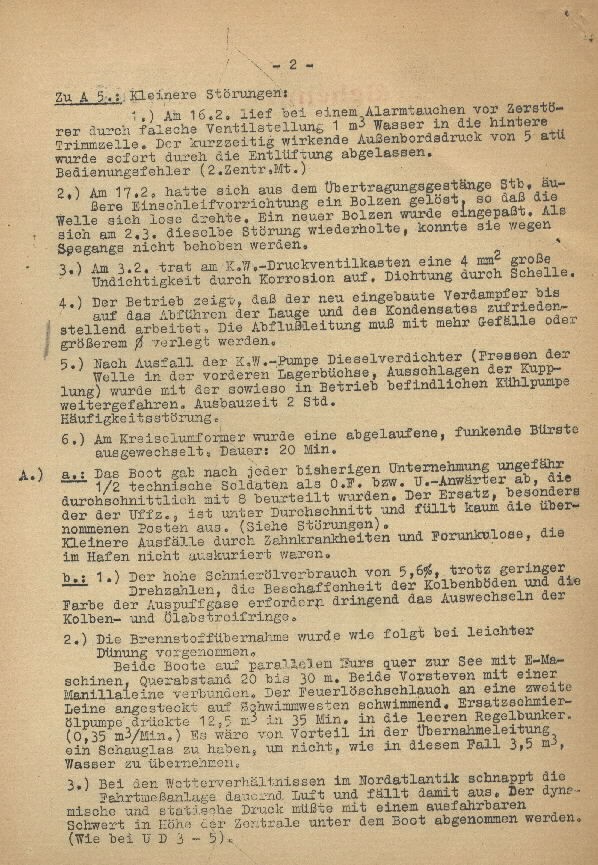
65
-3-
4.) In the last War Diary the average error percentage of the electrolyte counter was confirmed. At high impulse, for example, long underwater cruise with high rpm’s or travel with both E–motors, the cells carry and indicate 100% false.
Available Diving Depth: A + 60 meters.
Total Operating Times since Commissioning:
| Port: Starboard: |
4,405 hours 4,409 hours |
04 min. 27 min. |
Total Operating Times Diesel Engines during the Operation:
| Port: Starboard: |
770 hours 795 hours |
41min. |
Cycles [rpm’s] Diesel Engines since Commissioning:
Port: 69,750,426 Starboard: 71,177,454
Cycles [rpm’s] Diesel Engines during the Operation:
Port: 12,008,700 Starboard: 11,458,820
C.) See Installment.
The Chief Engineer
Signed: Boer
1st Lt.. (Eng.)
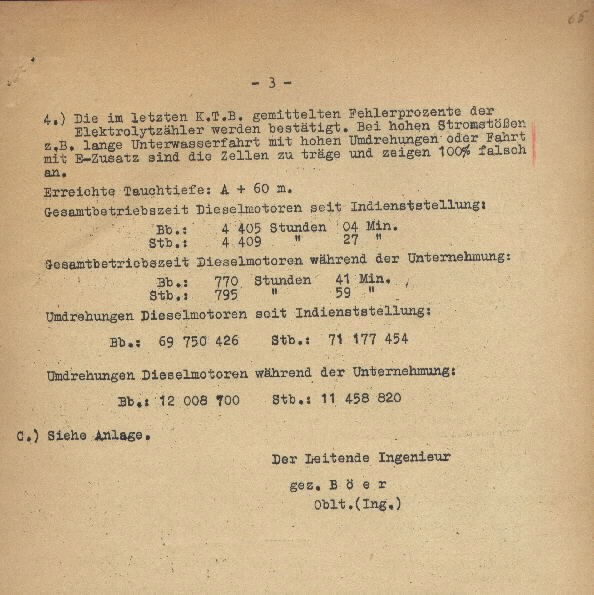
-4-
Remarks by the Flotilla:
Additionally A 1.: No more remarks concerning the cool water pump problems.
The rattling and grinding sounds from the main clutch coupling during underwater cruise (rpm’s up to n = 230) are a phenomenon which appear in almost every boat and up to now usually are accounted for by the loss of brushes in the main clutch coupling. It remains to be seen, how continuing minimal force in the propeller can be divided. It stands in each case that by reporting these rpm’s (on the fringe of the critical zone) the main clutch barely tipped the balance and therefore the rattling and grinding sounds developed. Diesel electric patrol cruise 250…. 240/150
Additionally A 2.: Terminal bearing switch reset, new gear, new chains. Chains are now in enough quantity to be delivered aboard for replacement storage.
The sliding in the clutch is not through the clutch surface of the standing rotary drives, but is through the translator cylinder of the hand drive – free run. The 4 cylinders to the free runners were non circular, with respect to where the roundness was worn and showed a small flattened surface.
Additionally A 3.: ./.
Additionally A 4.: Due to further depth charge damage (depth charges dropped ahead), at the Yard, a 30cm long rupture in the side of main ballast tank 8 toward the water tight bow was discovered, explaining why the boat always leaned further toward the nose [bow] during the return journey. Additionally, the largest section of the external shell hardened section in ballast tanks 8 and 7 buckled.
Additionally A 5.: ./.
B.) b 1. Piston rings replaced, two oil wiper rings rebuilt.
b 2. Inspection glass in the pass over line was shutdown for corrections.
b 3. That gave cause to a further severe pressure hull break through.
The Flotilla Engineer
[signature]
Lt.Cdr. (Eng.)
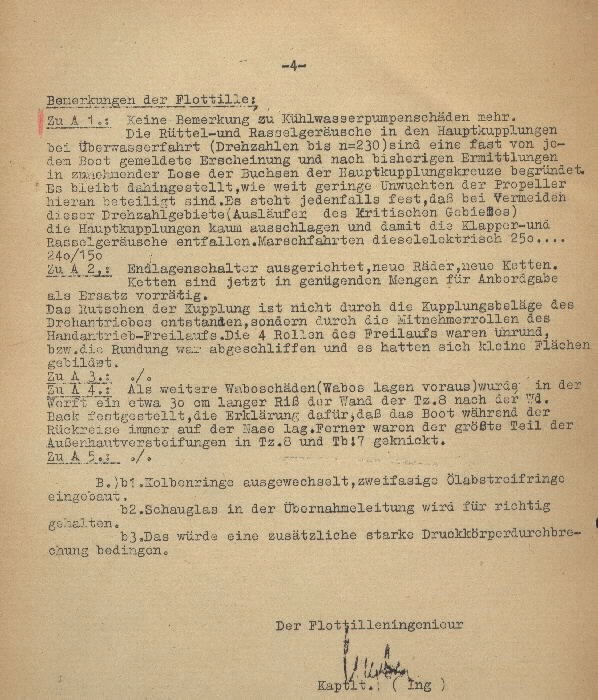
505
Secret!
War Diary
“U. – 107”
Section Machine
Operations from 21 April to 11 July 1942. (6 Operations)
A.) 1.) Diesel obstruction – cool water pumps, exhaust gas flapper valves starboard fuel leak, separator failed.
2.) Aft hydroplane failed.
3.) Vapor concentrate pumps vaporizer failed.
4.) Trim pumps unclear.
5.) Central bilge pump is emitting a rattling sound, leaking, not watertight.
6.) Both negative buoyancy tanks leaking.
7.) Conning tower hatch.
8.) High speed ventilating 7 starboard leaking.
9.) Battery: Abnormally high water consumption, high deterioration of efficiency.
10.) Junkers – compressor obstruction.
11.) Port head valve leaking more.
12.) Minor damage.
Additionally A 1: a) Both drive machinery controls for the cool water pumps and the closing mechanism of the port external valves, starboard internal and external pressure valves were removed on 9 November and 13 June. On 16 June a thump in the starboard pumps was felt. The prompt investigation following shutdown revealed:
Break in the closing mechanism and severe damage in the starboard location for the external suction valve suspected cause:
Break in the setting ring pumps must be repaired. Duration of work 31/2 hours. The new drive (with a case hardened shaft) for both cool water pumps works without showing sparks.
b) Spindle guide, grinding device and stuffing box in starboard internal exhaust gas flapper valve leaking in spite of being pulled on with considerable force. Tried to close the starboard external exhaust valve under water as a step towards after cooling, with more water allowed into the exhaust gas space. Turbine housing and flapper valves must be included. In spite of frequent lubrication the starboard flapper valve had very difficult going temporarily. Because of emergency alarm dives, more water had entered into the cylinder of the starboard engines, raising the water content in the starboard collection tanks to approximately 1%. For travel at higher rpm’s repairs will be needed. By the indicator diagrams and the color of the exhaust smoke, additional repairs must be made to the piston rings following the water break through.
c) From the 10th to the 12th of June following the fuel oil shortage the following repairs were made:
Port I 1 5 m3 (not serviced, was previously employed. Normal take over.)
Starboard I 1 I.5 m3 (possibly through the reserve pumping, collector tank-high leakage)
Starboard 2 1 I m3 (not serviced)
Fuel transferred following Flotilla orders. From all tested leads, fuel flows out. Cool water pump was deployed. No oil leak.
d) The separators from the boats were exchanged with the other boats during the last overhaul at the Yard. Through the leaking setting ring over the journal bearing, worm gear and shaft, an oil water compound is leaking out. After 24 hours of operational time the separator continues to produce a grinding sound. The teeth of the worm gears were run down to half their size, a repair job on board was not possible.
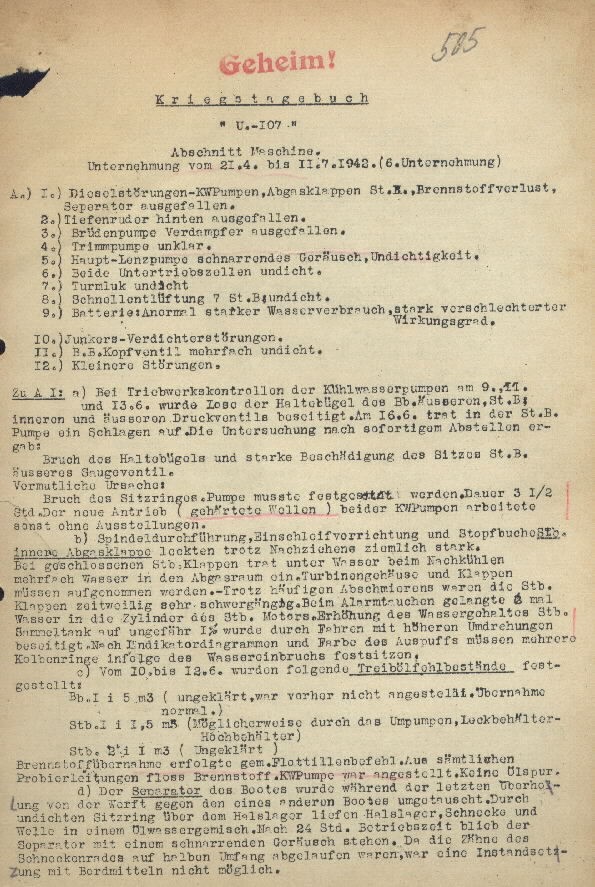
-2-
e) The starboard cool water security valve operates with fatigue in the spring (opening of 0.9 kg/cm² and remaining in this position) in spite of immediate shutdown of the machine a severe water invasion takes place in the diesel compartment. The spring span reaches up through a 3mm high strap. Duration of repair work 1 hour. Valve leakage closed.
Additionally A 2: On 3 May. The stern hydroplane wedged into the position “fixed high” by breakdown of the terminal bearing switch. Boats which have installed this terminal bearing switch, suffer the corresponding steering problem. The switch axle was rusted and the bushing had been eaten away. The rudder spindle was assisted with a set of pulleys and “cow foot” and rotated from the end bearing, the terminal bearing switch was replaced with a new one, which was ordered. Duration 8 hours.
On 31 May. Smoke came from the stern hydroplane motor due to an underwater attack. The motor was contaminated by reduction gear oil, which completely covered the shaft seal of the knockout spindle. The collector filled at a high rate.
The motor was rebuilt, completely cleaned, anchor and magnetizing coil calibrated, collector face turned on a lathe and the brushes replaced. After lowering the oil inspection mirror into the drives lower half, the high level indicated no further damage. Duration of repairs 30 hours. The boat must go through an underwater mounting of the motors, including a mandatory rebuilding of a section of the hand driven rudder lead.
Additionally A 3.: On 12 June. Located in the vapor concentrate pump, a grinding sound. Due to a minor loss of supply, necessary work on the underwater steering piston has been blocked, and more teeth on the drive gear and the drive shaft on the housing lead were broken. After completion of the piston the pump housing is set with flanges on both sides and the vaporizer closed off as the excess pressure fresh water generator is placed into operation.
| Excess pressure: Capacity: Salt content: |
0.1 kg/cm²
6 – 8 mg/L |
Additionally A 4.: Preparations for a short operating time lead to both trim pumps producing a simultaneous rattling sound, which from the last operation, came from the inexact flow out from the submerged engine pumping shaft during the return journey. (Work Order placed: correction of the shaft) Till the 13th June there will always be continuing work done on the rubber muffler, with 4 more new clutch bolts installed. On 13 June it was noted that an abnormal warming in the bearings of the worm shaft and a loud rattling sound from the pumps began. After shutdown of the engines the worm shaft with bearings and the worm gear could be removed. Through the rupture in the cooling coil, seawater had settled in the oil sump. The worm of the spherical bearing was severely rusted and corroded. The bronze worm gear was badly run down on the side. In the oil sump there laid a large amount of bronze silt.
The cooling coil became obstructed on the flange, the spherical bearing was readjusted after lubrication. After the collective reconstruction work on the pumps, it was possible for short time operations without bearing warming and loud noises occurring. It was covered over, so safe operation of the spherical bearing without grease lubrication was possible, and why draining the valve for the oil sump was advised as unfavorable. This is why cruising at sea without rebuilding the pumps and no oil change can be done. Duration of repairs: 70 hours.
Additionally A 5.: Since the 25th of April employed both of the main ballast pumps. Especially when under water, ballast drains under pressure remain regulated. Due to striking of the recoil sphere by high air pressure, rattling sounds are produced. Check valves venting valve must be leaking. Additional closing of the leaking ventilator valves and the check valves did not remedy the damage. The ventilation system must be evaluated at greater depths with a wooden plug wedged in, in order to prevent a severe water break through. (Pumps are always under external hull pressure, the Kingston foot valve main ballast pump leaks seawater internally causing seawater entry into the main ballast pumps.)
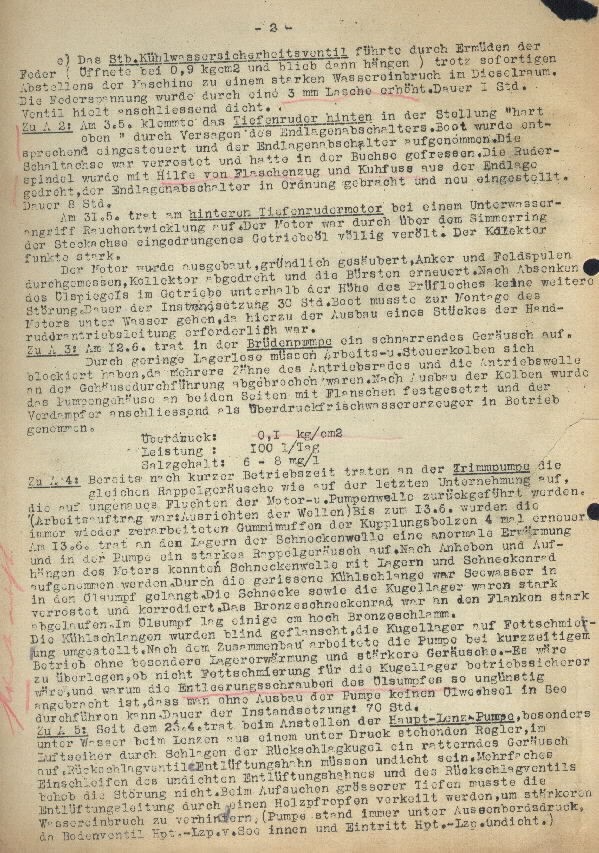
-3-
Additionally A 6.: Since the 15th of May both Negative Buoyancy Tanks have been leaking. With the increase in external pressure causing flooding, inspection of the pumps for external flooding was performed. Due to the corresponding collapse from flooding pressure within the boat, it is necessary to attain emergency leak sealing.
Additionally A 7.: A leak in the tower hatch which occurred while diving to attain periscope depth, was not stopped by readjusting the wedge pushed in at the terminal position. This hatch has over a ¼ circumference gap, and must be replaced with another hatch of exact fit according to the setting plan, at the Yard.
Additionally A 8.: On 12 May. During the course of exhaust blowing, a bad leak in the rapid ventilation group 6/7 on deck was noticed. A piece of the water tight rubber seal ring for the valve heads for starboard 7 had sprung from the edge and wedged between the setting. The valve head was rebuilt and the rubber gasket replaced. Duration 1 ½ hours.
Additionally A 9.: The last capacity test of the battery in Lorient yielded an efficiency rating of 75%. Especially after failure of the freshwater generator for distilling which led to abnormally high water consumption during this cruise and dependence placed upon a single tank causing serious difficulty.
It is possible that a part of the element had suffered an internal short circuit through the accumulation of a lead deposit, which was noticed and must have been accumulated itself through sulfidation of the accumulated mass. This element must be rebuilt and the slag mass removed.
On 8 July the battery was charged at 03:45 hours to 600 Ah [ampere hours] with gas pressure. According to the engine log the existing available ampere hours were at least 10,274 Ah. After discharging 4,944 Ah for the drive, 2,070 Ah for the network system and the loss of 165 Ah, the conditions must have an available capacity of 3,155 Ah for up to 12 total hours of underwater cruise.
Around 23:10 hours the voltage meter of the main switch table indicated 109 volts, which corresponded to a residual capacity of approximately 1,500 Ah for low frequency. As higher levels for the periscope depth were ordered at about 23:13 hours, for both high frequencies ordered, the voltage immediately sank by 94 V. Then the hydroplane drives failed due to these small voltage drops, the for plane remaining in a high position, and the aft planes positioned at 10 low. The communications system shutdown. The boat could not remain in a stopped position, and therefore had to dive.
Available Capacity: 7,119: 10,274 = 69%
Ratio of Required Capacities: 7,119: 12,150 = 59% (50 hours current)
Additionally A 10: Total Drive Time:
Since Last Overhaul:
a) By rebuilding the internal exhaust gas valves, the location of the corroded half, eaten away by rust was discovered.
Reconditioning with on board equipment impossible: the external valve leak halted.
b) On 13 May the compressor would not jump spring. Preparation of the fuel pumps by clamping the pump plungers. As a result of wear, the regulator spindle was prevented from rotating at a cant. The locking mechanism over the relief valve was as a result of this, blocked. Duration 12 hours.
c) On 25 April. During air pumping the machinery had to be placed in park, because of pressure damage in the Stage 3 and 4 steps. After rebuilding the suction pipes for stage 4, iron filings were found between the suction valve head and the valve setting, so that a break down was made possible in stages 4 through 3. The origins of the iron filings was impossible to determine, stages 3 and 4 were in perfect order. After a 20 minute test run additional similar obstructions were determined.
Even with repeated treatment, the 2nd, 3rd, and 4th stages could no longer be air started. The machine would not start. The cause of the damage was not determined, the sphere in the check valve for the air start circuit before stage 2 was jammed, and because of this, the steps involved in air startup were hindered. The investigation of the check valves revealed: The setting for the retaining spring and the retaining spring itself failed. The failure of stages 3 and 4 also accounts for the following: Because of the failure of the retaining spring, and its mounting place in the check valve of the air start circuit for stages 2, 3 and 4, the ball valve’s rotation was finally jammed with the running of compressed air through the machine. Splintered iron filings migrated with
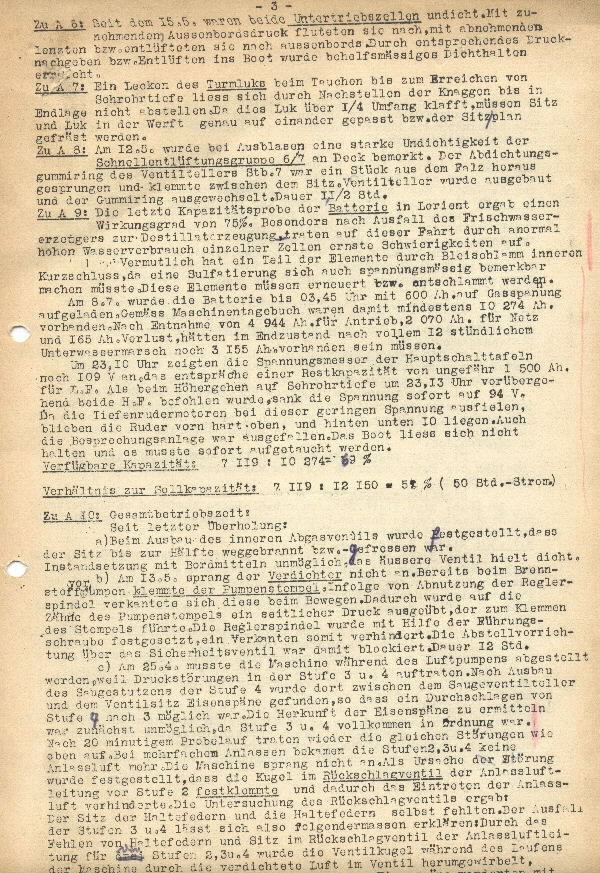

-4-
the compressed air through the machinery and gave rise to the valve obstructions. Duration of the repairs: 15 hours.
The newly installed cool water pumps and automatic starting mechanism functions obstruction free.
Additionally A II: On 3 June and 28 June the port outboard valve was jammed during an emergency dive, before the “position” half turn, by unknown causes. Valves must be removed at the Yard.
Additionally A I2: a) As a result of impurities, probably metal shavings (see Obstructions 10 c), in the high pressure air system, the valve setting of the main blow valve and valve blowing compensating tank and negative tank must be repaired on a lathe.
b) On 22 April. Increasing leakage in the electric compressor stage 3 was discovered.. A slight pressure increase in stage 2 occurred, the jammed Suction and Pressure Valve of stage 3 opposite the auxiliary has been replaced. Duration 1½ hours.
c) By loosening a clamping screw and lubricating the contact in the diesel relay receiver system E-machinery the alarm for theStarboard Machine Telegraph failed. Duration of the repairs 4 hours.
d) The hull blowing valve 7 starboard, 6 port and 4 starboard were incorrectly packed with non oil insoluble (hemp) material and leaking. It was packed new with asbestos-graphite and the leak halted.
e) In spite of frequent and routine water draining, the High Pressure Drainage Pipe failed in the operational area, especially frequently under water, 6 cartridges for the Draeger-Automatic Type D 2500 [underwater escape system] damaged through water penetration. Apparently this construction was placed opposite the water condenser and is very sensitive.
f) Despite the appropriate rolling [maneuvers] the Port Negative Tank Transmitter failed through the collapse of the chains minimal operation, with normal difficulties.
Normal obstructions.
g) Aircraft bombardment – Failures
On 15 May an aircraft bomb struck abreast the starboard beam. Minimal failures in the secured and fastened down systems, such as lamps. Course speed receiving system in the conning tower and the depth gauge in the tower remain out of operation.
B.) a) : Nothing special.
b) I: The lubricating oil consumption is indicated at 3%, indicating that the newly installed piston and oil wiper rings are functioning well. The severe black smoke coming from the starboard engines towards the end of the operation is due to the second sea water leakage, during the return journey. A section of the submerged A1 damage had not appeared until after a 5 week lay up at the Navy Yard.
2: Damage A4 indicates, that a second reserve winding point in the diesel room – trim – and auxiliary bilge pumps (piston pumps) are highly essential to the security of this boat type. Collectively hitherto existing operations indicate: that with breakdown in the trim pumps, a bilge stoppage in the bilge with unreliable gyro pumps in the end space is not imminent.
3: Damage 12 e indicated that especially for the operational boats in the tropics it appears favorable, the sensitivity of the low pressure automatic exchange connected to the high pressure distributor, is hindered at the low discharge rate by amassed sea water which had leaked in.
4: The taking on of 43 cubic meters of fuel from “U-459” followed quickly without obstruction.
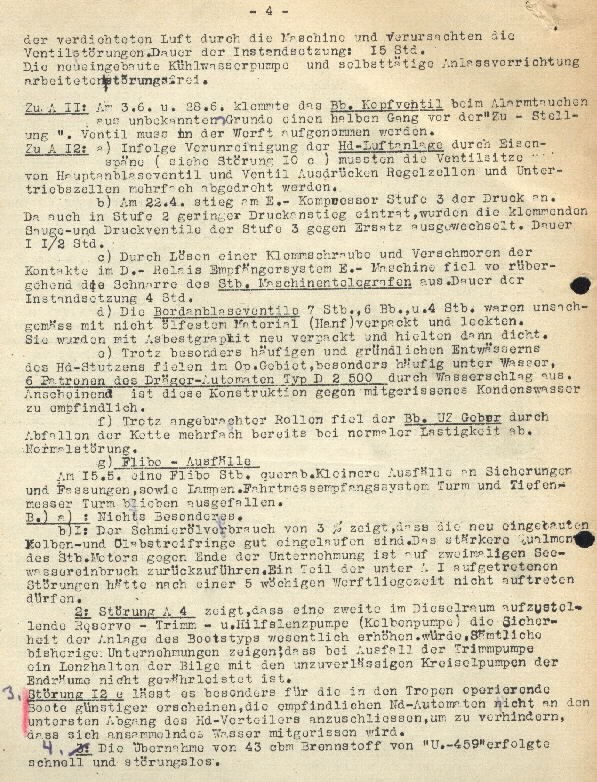
-5-
5) There exists no possibility to drain the clogged drain connection to the diesel compartment, through a tube from the trim pumps into the bilge. Accurate real measurements taken on board for the required threaded coupling are to secure against high water leakage.
6) During the last Yard lying up time, the plexi water level for auxiliary tanks and the plexiglass tube for the Papenberg [a very shallow depth gauge designed to show level of waterline with respect to different parts of the boat.] were not cracked, despite considerably close air bombardment.
Port motor |
Starboard motor |
|||||
Total running time since commissioning: Total running time during the last operation: |
day 220 37 |
hour 18 7 |
min 33 37 |
day 221 37 |
hour 15 22 |
min 30 15 |
| Revolutions since the commissioning: Revolutions during the last operation: Attainable diving depth: |
83,148,596 13,398,180 A + 60 meters |
84,922,374 14,144,920 |
||||
C.) Consumption:
Combustible propulsion material, see installation.
Commissioning of the boat on 8.10.1940
| witnessed: signed,Gelhaus Lt.Cdr. and Captain |
The Chief Engineer |
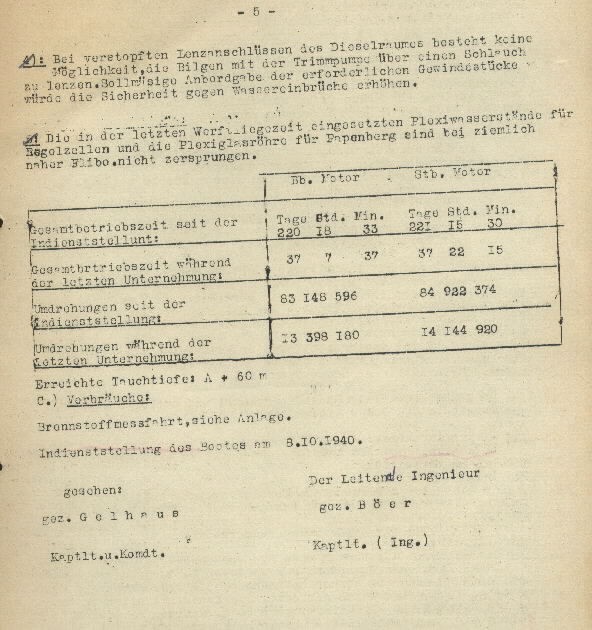
Remarks by the Flotilla:
Additionally A 1 a) The beginning of the obstruction is probably a result of a break in the setting rings, causing the loosening, through either being pulled or struck, of the suction valve mountings.
1b) Cause of the water leak: rupture in the cooled dividing wall for the super charging group between the turbine and the supercharger induction fan. (2. Failure in the last half of the year) Repairs with welding were successful, dividing wall must be rebuilt.
1c) Loss remains unexplained; the internal tank was measured and had attained filling to the specified amount during the transfer of fuel oil.
1d) Shielding of the journal bearing was not adequately thick.
1e) The cool water security valves, which frequently failed due to water leakage in the diesel bilge, must be tested in the boats at regular intervals (sometimes weekly). Only so one can be secured against surprises!
Additionally A2 a) Burnt debris coming from welding condensation water has penetrated the spindle terminal switch, also damage caused by coating over the covering to the spindle bushing.
2 b) Breakdown in the retaining ring gasket; in this position it was an isolated case.
Additionally A 3) The mechanical damage in the vapor concentrate pump is hopelessly irreparable; it is possible, that with such a failure the vaporizer rather than the high pressure fresh water generator may be involved, all boats must be attentive to this.
Additionally A 4) The motor to the pump did not fly out of control, so the elastic coupling continued to function, but the pump runs noisily and irregularly. Because of this, an adjustment is difficult as no body bound bolts had been set aside. The rupture in the cooling condenser coil coincides together with the concussion and irregular running. During the mounting of the pumps at the Yard, a fault in a spherical ring for the alternating ball bearings existed; it remains to be seen, whether it was lost during the assembly on board, or it was already faulty previous to installation, and the destruction of the worm gear drive was furthered along by this. – New drives.
Additionally A 5) After repairing the check valve and relief cock the pumps functioned obstruction free.
Additionally A 6) Further corrosion in the ventilation piping of the space under the cell ventilation! It is frequently required to listen to the pipes behind the thick sections of the bulkheads.
Additionally A 7) As requested in the old requisition, the tower hatch bearing strengthening and stabilizing was implemented, make it much more solid, since this was done, obstructions in the double spring hatch are rare. – This boat is now the first one to have double springs installed.
Additionally A 8) Isolated case.
Additionally A 9) All batteries in the boats must be monitored. Through lining up, especially the forward battery half, but necessary with all cells, it was determined that there has been a deterioration in the voltage capacity when compared with the earlier measurement. The capacity remains for all cells minimal, and the amounts (20 – hour currents) are for the bow cells 64% and stern cells 61%. – With the multiple previously measured loads- and discharge modes used in place here, the potential of 146 volts could not be attained. With the increase in additional charge this potential of 146 volts will increase the temperature in short time to a final value of 45°. The boat endured, during the current operation, high temperature increases and with it, a high increase in water consumption for safety, in general a close charge is not attained with a greater gas pressure tension. It should be further possible to frequently depress the charge, around the batteries positioned in good line formation. After the operation the battery exchange (in conjunction with basic overhauling) will be performed.
Additionally A 10 c) The certification was specified.
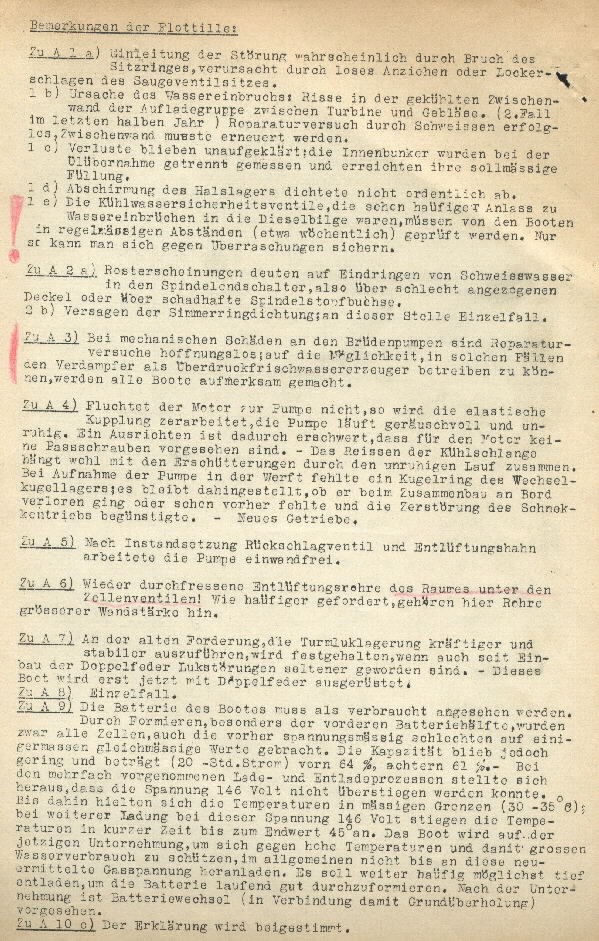
Additionally 12 a) The troublesome failures in the chains – transmitter were also recorded from the boats as a “normal obstruction”.
B b 2) IXC Boats have a reserve for the drain connection to the auxiliary cool water pumps. In these connections, it should be mentioned, the drain connections, with the exception of during emergencies, were conceived by design and under normal circumstances, to be sealed with lead, so that unnecessary contamination in the lube oil cooling evacuation apparatus is not obstructed, and can continue to generate cool water.
B b 3) Good advice; for new construction is no longer feasible.
The Flotilla Engineer
[signature]
Lt.Cdr. (Eng.)
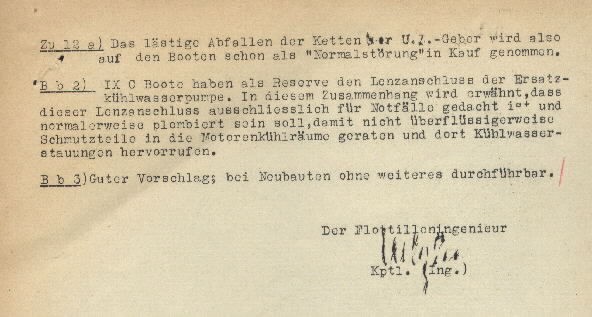
Brennstoff-Messfahrten “U 107”
[Fuel Consumption – Test Run “U 107”]
[Columns across top of Fuel Consumption Test Run chart [left to right]: Date; Propeller rpm after engine indicator; Condition of the boats; Duration of the test measurement run; Speed: a) After logarithm, b) After test run; Weather; Amount of electric current consumed: a) Engine side, b) Generator side, c) Circuit grid, d) Battery; and Fuel oil consumption: a) per hour, b) per [unreadable].
Other terms in chart:
voll ausgerust boot = Entirely equipped boat
Nur [] als Zelle = only [] in all tanks
Alle Aale = All wooden shafts
ausgeblas = Exhaust blowing
Etmal nach Besteck = Days reckoning after taking sighting
Sm seemeile = Sea miles; nautical miles
Sm/h = Nautical miles per hour
Seegang = Sea state; rough seas
Leicht = Light seas
Dunung = Swells
A = Amperes
L/h = liters per hour
L/sm = liters per nautical miles
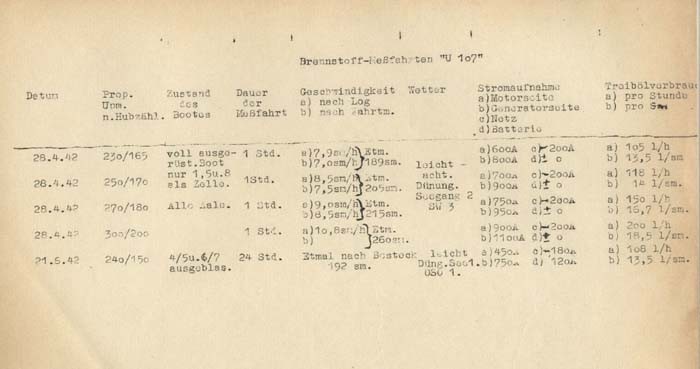
U-505
Secret!
War Diary
“U 107”
Section Machine
Operations from 30 January to 25 March 1943 (8th Operation)
A. 1. Water leak in the control room (switchboard fire- sky periscope damaged).
2. Water leak in the diesel engine. [Inside this square is a Document registry number for U-505].
3. Aerial bombardment damage.
4. Minor damage.
Additionally A 1.: Operating combinations [propulsion usage] and necessary course changes caused by the supply meeting on 31 January. Continuing multiple serious water leaks in the tower and control room bilge (tower hatch opened as the result of a flying cable). In spite of running the pumps and continuos vent blowing in the tower water condenser, steps continue to fail. At A – 40 m the auxiliary switch board 3 Power caught fire. As a result, the carbon dioxide concentration caused by the fire extinguishers (in some cases, control room personnel succumbed due to not having deployed diving lungs) necessitated surfacing to air vent out the carbon dioxide. The partially burnt contact rail and switch were repaired on board in approximately 10 hours. Only the throw over switches for the main bilge pumps remained not cleared after repairing the switches for battery II. Because of loss in the magnetic contact closing, the contact transmitter for the pressurized oil system for the entire operation failed. The system was driven by hand.
Over the tower bilge, the encasing tube for the fixed eye level periscope was half flooded (pumps were tightened to halt leaking in the control room and diesel bilge pumps). Optics for the reflecting mirror transport carriage and the ocular eyepiece part were removed, dismantled and cleaned. The encasing tube’s half filled remaining water was pumped out with a connection hose, cleaned and connected up to the warm air system and dried out. Duration of the repairs 12 hours.
Additionally A 2.: In spite of the cinched up throttle valve, both motors made 300 rpm’s even with water leaking through the ring stuffing boxes and into the clutch housing. The draining had to be opened up. Indicator cocks were intermittently opened in spite of running the pumps. Knocking sound from both clutches alternately (alarm dives) due to light water. After further oil changes and unwinding the clutch spring from around a gear, the clutch ran without obstructions. After draining during the running operation, both engine’s crankcases, camshaft cases and sump tanks were cleaned and the oil changed.
Additionally A 3.: On 4 March at A - 45m (10° trim) 3 good sedentary buoyancy cells.
Failures: 1. Atlaslot [Atlas brand sonic depth finder] completely out of operation.
2. Voltage safeguard for the starting compartment exhaust air blower does not hold. (Resistors replaced).
3. E- compass amplifier tube (replaced).
4. 200 m depth gauge in the tower (indicator jammed in final position).
5. Contact spring in the steering rudder circuit in tower broken (rebuilt).
6. Watertight bulkhead between main ballast tank 1 and watertight aft ruptured (main ballast tank 1 vented by blowing over the watertight stern).
7. Aft WC porcelain sprung.
8. Safety equipment breakdown normal, incandescent light failures 70% (poor manufacturing).
9. Ventilating mountings in the watertight stern compartments blocked.
10. Diesel foot valve portside locked in “half open”. Audible breakdown due to an apparently bent screw propeller.
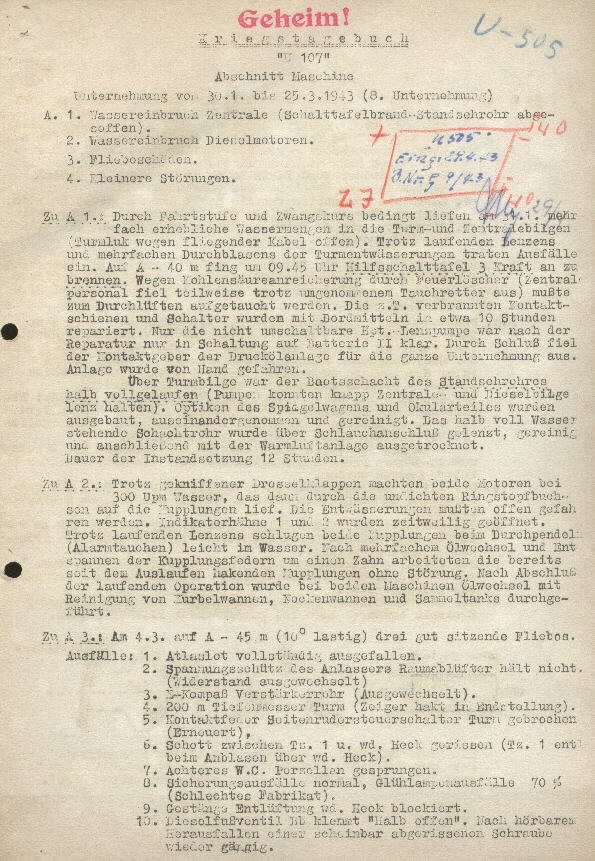
-2-
Additionally A4.: 1. Flooding valve lines tube 5 in main ballast tank 1 leaking severely. Sailing without torpedo tube flooding valve.
2. Trim clock-transmission gear is running. A newly machined gear was, likewise, running after 14 days. Clock remains unclear. (replacing it opposite the torpedo flood clock control, as a result of taking measurements is not possible).
3. Rheostatic resistance Varta-Lamps in the tower are entirely shut. Cases were set in a dry location.
4. Collective hull blowing valves not set in place as normal, in the spindle guidance there is undesirable leaking.
5. Separator failed after 48 operating hours. (Clutch coupling and bearing damage).
B. 1. The personnel rotation 2/4 was laid out for boats recalled with various present time operational errors, requiring leak proofing in the security bulkheads for all boats pulled from convoy operations.
2.a. The new Deschimag [Deutschemaschinen AG; German Machinery Inc.] spark extinguisher with throttle valves have not reduced maximum performance for temperature correction. Sparks fly to a minimum as previously observed. With entirely smooth seas, slow travel with closed throttle valves and in a normal floating location lately causes the engines to take on considerable water. - Cause must be identified and removed.
b. For the type IX b blowing out is expedited by the simplified blowing system recharger for the exhaust gas compressor in ballast tank 7 port and starboard.
The very desirable advantage of converting half a tank to a cell can not be used.
On the availability of the standing bunker contents for ballast tank 2, the gravity head tank and test run connection continue to drain down.
c. The thorough and frequent draining in the leaking areas within the drainage for the high pressure connectors could be improved with the replacement of a steel setting.
d. The boat is ready for running after the last ballast re loading of 44,000 mkg [mkg = meterkilogramm; kilogram meters] (To establish a ready fighting trim, 1 ton of drinking water must be pumped).
e. The new, silent rudder control magneto appears to work inadequately. The strong audible grinding sound is caused by the rudder drive servo.
[The following entry, f, refers to the diagram sketch on the original page.]
f. With the on board remedy tested the spring suspension 200 meter depth gauge in the control room is well mounted in case of aircraft bombardment and depth charging.
[See Diagram for suspension spring mounting of depth gauge on pressure hull wall]
g. The new MAN cool water pumps function obstruction free.
h. The basic overhaul of the Junkers compressor delivers gratifying performance even in severe sea conditions and is dependable and problem free.
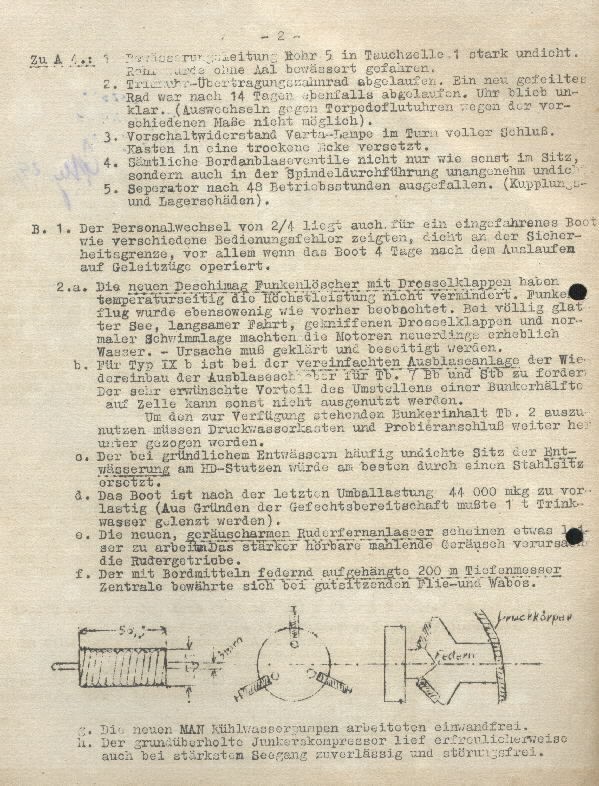
-3-
c. Consumption: Table Layout.
Attainable diving depth: A + 70 meters, initial trim a little more than 35°.
Commissioning: 8.10.1940.
Operational hours for the Diesel engines since the commissioning:
Port 7,081 hours 15 min. Starboard 7,005 hours 54 min.
Operational hours during the last operation:
Port 567 hours 28 min. Starboard 581 hours 28 min.
RPM’s for the Diesel’s since the commissioning:
Port 112,777,224 Starboard 110,458,986
RPM’s during the last operation:
Port 9,274,630 Starboard 9,501,050
| Witnessed: Signed: Gelhaus Lt.Cdr. and Captain |
The Chief Engineer |
Remarks by the Flotilla:
Additionally A 1.: Concerning the Radar Observation Equipment - slamming the tower hatch shut to keep out over flowing sea water, because the large amount of water flooding has already caused the break out of fire in the auxiliary switchboard No. 3.
For plugged up tower drains which now occur in boats of the flotilla, using an air blowing tube attached to a nipple above the stop cock is effective.
Additionally A 2 and B 2 a.: This boat, which entirely from the beginning operated without a spark extinguisher, on many later long operations used an older method to extinguish sparks. In response to the directive, we had installed the resistance equipped Deschimag – Spark extinguisher. It appears it had created a suction effect within the exhaust gas leads. The boats exhaust gas lead now performs in an entirely flawless manner without a spark arrester.
Additionally A3 and 4.: .//.
B. 2 b. An exhaust compressor should remain a standard issue on the Type IX B.
2d. Failure of the Yard. Boat was adjusted by 36 mt [metric tons?] ballast.
The Flotilla Engineer
(signature)
Lt.Cdr.(Engin.)
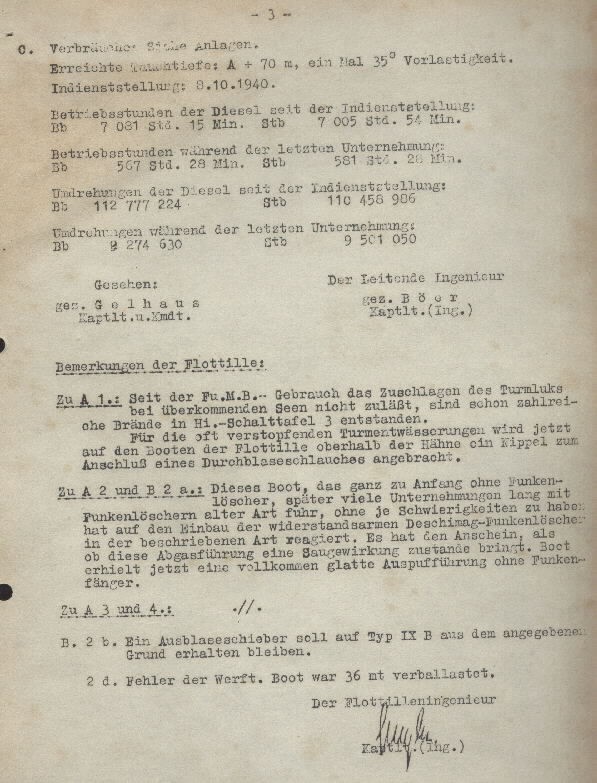
Secret!
War Diary
“U 107”
Section Machine
Operations from 24 April to 26 May 1943. (9th Operation)
A. 1. Breaking the surface blowout.
2. Rudder connecting gear forward hydroplane unclear.
3. Diesel damage.
4. Minor Damage.
Additionally A 1.: On 29 April the boat foundered during a diving maneuver, tower was free, continued under way. At 12 meters (without water leaking) intercepted and dived.
Cause: Due to the combination “vent valve cock” and “blow manifold” venting no. 8 during the test running of the ground main blow valve, venting went unnoticed. (Position Indicator Light Switch “closed”).Until the order, “collective venting in the follow up test run and tightening up” problems developed in the aft section vents through ventilator 8. – Pipes were separated on board.
Additionally A 2.: a. From 1st May while on a submerged operation, from the forward hydroplane, externally, an audible cracking sound was heard. (up 20° to 15°).
b. On 18 May the forward hydroplane jammed during a test dive from outside and the motor drive was jammed in the position 2° down. The inspection on the deck indicated that the rudder plane leaf was broken free from the drive due to harder and harder sea swells. (Cotter pins or bolts must be inserted). – Boat maintained buoyancy at periscope depth at sea state 4. With Alarm: “All men forward”, two cubic centimeters in the negative buoyancy compensating tanks, caused an approximate 35° load shift in the trim.
Cause: Not discovered.
Additionally A 3.: a. Shortly after putting to sea:
Fuel pumps: 2 overflow valves fractured, additional pumps operating irregularly, starboard 7 seized up, all fouled.
Valves: Port 1 entry -, starboard 8, port 3 exit- severe leak due to damage.
Heads: starboard 3, port 4, 5, 9 blowing. Packing port 9 replaced. Stud bolt starboard 3 broken.
Motor vibrating at severe 400 rpm (pipes and reducers have multiple breaks.)
b. Towards the end of the operation:
Port exhaust gas turbine fractured, encasement housing cracked (water running in the drainage), both turbines have visible oxidation coating.
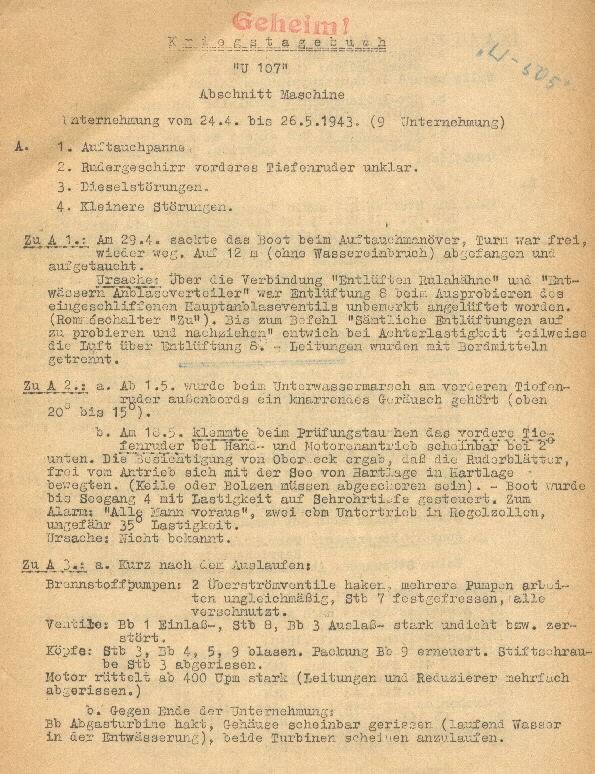
-2-
Additionally A4.: Minor damage:
a. Stem pipes leaking severely after additional tightening up and lubricating (gear rim and stud bolt worn down, shaft off center and main clutch coupling has light vibration?)
b. Main exhaust valve steel setting has visible light eccentricity [off center], leak is flowing.
c. Battery accumulator bilge II has a 1 cm thick, spongy layer of residue ( rust, decomposed paint, caulk?) remedying it is therefore not possible.
B. 1. .//.
2.a. With the damage in A 1 as well as “Special Combat Operation Machine serial number 37” package 3 in the critical point for ajunction to the “ventilation cock” and “blow manifold drainage” with a joint vibration muffler.
b. The smooth exhaust operation continued without sparks flying out. Electrical resistors, for the secure operation of the throttle valves are mandatory with the medium level sea conditions and excessive water penetration during half the operation.
c. The new Deutsche Werft AG cooling apparatus for the electronic compass system operates silently and problem free (15.5° C outside temperature and 32 minutes, for circuit switching operation). This is also mandatory for the onboard servicing of the 2 reserve manometers [pressure gauges].
d. Viewing head for the observation periscope despite heating is sometimes cloudy.
e. Fuel transfer with “U 231” with the trim pumps: 6.6 cubic meters per hour. Internal fuel cell 1i port and starboard done operated with connected bilge.
f. 2 successive switching operations with the drainage valves have performed well with the high pressure pipes.
g. Junkers – Compressor: manufacturer number: 30 989 type 4 FK 115 operational time: 33 hours 30 min.
No obstructions: Exhaust gas leads under top deck good.
Attainable diving depth: 2A + 20m.
35° sternward pitch after breakdown of the forward hydroplanes due to all the emergency dives.
Commissioning on the 8th October 1940.
Operational time of the diesels since commissioning:
Port 7,412 hours 30 min. Starboard 7,497 hours 48 min.
Operational time of the diesels during the operation:
Port 396 hours 43 min. Starboard 434 hours 46 min.
RPM’s of the diesels since commissioning:
Port Port 114,201,311 Starboard 117,548,914
RPM’s of the diesels during the operation:
Port 7,290,580 Starboard 8,187,360
| Witnessed: Signed:Gelhaus Lt.Cdr. and Captain |
The Chief Engineer |
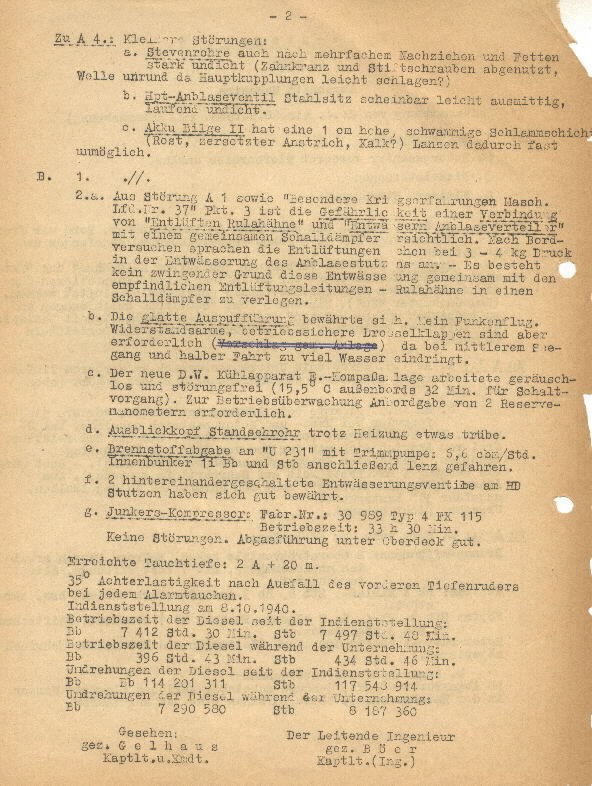
-3-
Remarks by the Flotilla:
Additionally A1 and B2 a.:
This break down has now occurred for the 2nd time. The order must be decreed that “venting cocks” be separated for transfer. (This is to be arranged for boats of the 2nd Flotilla.)
Additionally A2.: Rudder yoke disengaged, spindle was fractured, a cotter pin bolt was lost, resulting in a severe vibration; also there is no more connection between the rudder blade and its containment apparatus.
Additionally A3.: After concluding the current investigation there was evidence of contamination, and from this the irregular operation of the pump drives was determined to be caused by corroded leads, and from the presence of suspended particles, which were introduced through the pressurized water forced through the fuel oil system. In addition to this suspended material, the fuel oil in the tanks interfaced with the pressurized water in copious amounts, high pressure water was then pumped and blasted through the system pipes in order to generate an anti corrosion effect.
Exhaust valve breaks in the latest time periods occurred frequently; Resulting damage was severe with damage to the port turbine rotors.
Additionally A4.: a. Stem tube bushings old and worn out, replaced.
B. 2.b. Indications are that the “smoothness” of the exhaust leads is confirmed.
A sturdy exhaust for the throttle valves has been mandatory for many years. The result, now an automatic clutch and a recommendation from Navy Yard Lorient for the chief engineer of “U 107”, for the throttle valves in “open” – position half for the exhaust gas flow to pass through. It is intended to put this in place on two additional boats.
In due course it will be reported on periodically.
g.The free goose neck rubber hose under the top deck exhaust gas discharge leads for the Junkers – compressors can now be closed according to the best indications.
The Flotilla Engineer
[signature]
Lt.Cdr. (Engin.)
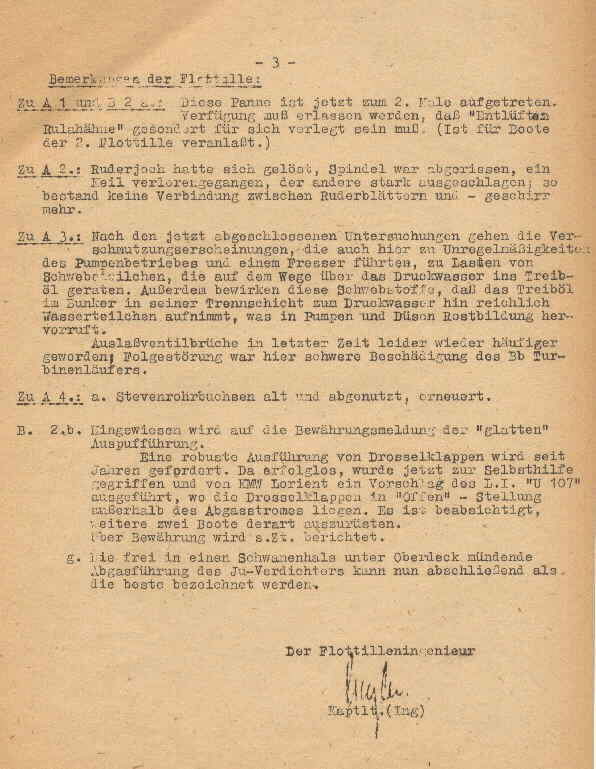
Note: The library has the following un-translated and fragile damage reports captured on U-505 from the following German submarines: U-106 (covering the period 21 Oct.-4 Apr. 1943), U-108 (Aug. 1941-24 Feb. 1943), U-109 (25 Mar. 1942-1 Apr. 1943), U-123 (23 Dec. 1941-8 Jun. 1943), U-124 (21 Feb. 1942-13 Feb. 1943), U-125 (Feb. 1942-19 Feb. 1943), U-126 (5 Jul. 1941-25 Jul. 1942), U-128 (25 Apr. 1942-15 Jan. 1943), U-129 (28 Sep. 1942-6 Jan. 1943), U-130 (1 Dec. 1941-6 Jan. 1942), U-137 (14 Sep. 1940-27 Nov. 1940), U-140 (26 Nov. 1940-), U-153 (10 May 1942-30 May 1942), U-154 (9 Feb. 1942-6 Jul. 1943), U-156 (19 Jan. 1942-7 Jul. 1942), U-157 (30 Apr. 1942-5 Oct. 1942), U-162 (7 Feb. 1942-8 Jun. 1942), U-168 (3 Mar. 1943-18 May 1943), U-183 (30 Jan. 1943-13 May 1943), U-190 (5 Jan. 1943-Aug. 1943), U-502 (29 Sep. 1941-9 Nov. 1941), U-504 (19 Jan. 1943-25 Jan. 1943), U-507 (4 Apr. 1942-4 Jun. 1942), U-518 (Jan.-Apr. 1943), U-521 (7 Jan. 1943-30 Mar. 1943), U-A (18 Mar. 1941).
[END]



